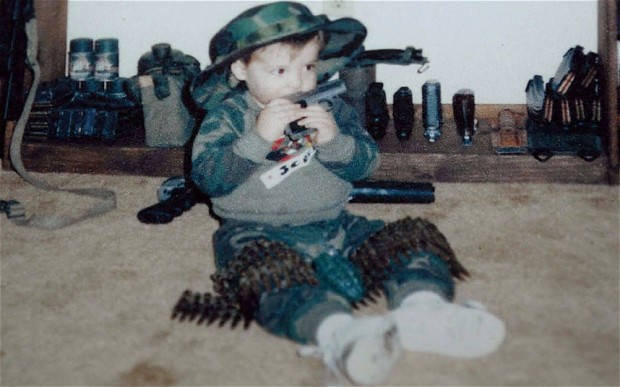The gun industry has long understood that it faces a slow-motion demographic collapse. As household gun ownership has steadily declined since the 1970s and the traditional gun market of white males continues to age, the firearms industry has set its sights on America’s children. Much like the tobacco industry’s search for replacement smokers, the gun industry is seeking replacement shooters. Along with the hope of increased gun sales, a corollary goal of this effort is the creation of the next generation of pro-gun advocates for future political battles. Gun companies have teamed up with “corporate partners” like the National Rifle Association of America, the gun industry’s trade association the National Shooting Sports Foundation (NSSF), and others in an industry-wide effort to market firearms to kids. The 2016 Violence Policy Center study “Start Them Young”– How the Firearms Industry and Gun Lobby Are Targeting Your Children offers a detailed analysis of this coordinated, industry-wide effort.
***
“He was just a good kid. He was everybody’s friend.”
On October 24, 2014, 14-year-old Jaylen Fryberg entered the cafeteria at Marysville-Pilchuck High School in Marysville, Washington, and shot five classmates, killing four, before turning the gun on himself. Unlike many school shooters before him, Fryberg had given little or no warning of his intentions. He was described as a popular “happy-go-lucky” kid who played sports and was recently elected as the freshman class’ prince in the school’s homecoming court.
But like many American children, he also had easy access to guns. He grew up with guns around the house, frequently went hunting with his father, and recently obtained a hunting rifle as a gift, which he called “probably the best [birthday] present ever, I just love my parents!!!” The semiautomatic 40-caliber Beretta handgun, which he used to commit the crime, was his father’s. Friends said that the teen had recently been involved in a breakup with his girlfriend and had sent disturbing messages via social media the week before the shooting.1
***
“It was insane how much he knew….He would say all the types of guns and could name anything.”
On June 10, 2014, Jared Padgett, a 15-year-old freshman at Reynolds High School in Troutdale, Oregon, opened fire with a Daniel Defense M4 AR-15-style semiautomatic assault rifle in the school’s boys’ locker room, killing a classmate. He then wounded a physical education teacher before eventually turning the gun on himself. In addition to the AR-15, Padgett carried nine ammunition magazines, including 30-round magazines, a .25 Colt pistol, and a knife. All the weapons came from his family’s home.
Subsequent investigation found that Padgett showed an intense interest in guns. One classmate said that he had “showed off about the guns he had,” saying that he had “bullets at home, bullets and guns.” On Facebook, he “Liked” an M4 assault rifles page (the type of gun he used in the shooting), and a page called “We WILL NOT Be Disarmed.” Friends and classmates recalled that he talked frequently about guns. Another peer added that “it was insane how much he knew” about firearms and that he “would say all the types of guns and could name anything.” After the shooting, a close friend of Padgett’s said he was not surprised to learn that Padgett was the shooter, saying that he knew “it was him all along.”2
***
He had plans to kill his family, set off bombs, and “kill as many people as he could.”
John David LaDue, a 17-year-old from Waseca, Minnesota, was arrested by police after he was seen entering a storage unit in a suspicious manner on April 29, 2014, and the witness became concerned and called police. It was soon alleged that LaDue had plans to kill his family, set off bombs, and kill “as many students as he could” at Waseca Junior/Senior High School, where he was an 11th-grade honor roll student. LaDue had bombs that he had completed, bomb-making materials, as well as gunpowder in the storage unit. Inside his home, police found three improvised explosives, 400 rounds of ammunition, and seven guns. LaDue had illegally purchased a 45 caliber Llama handgun and had also stolen firearms from his father.
LaDue had a longstanding fascination with guns and famous mass shootings. Speaking to police following his arrest, LaDue admitted that he idolized previous mass shooters, such as those responsible for the 1999 Columbine High School attack, and added that he had hoped to kill more people than the 26 children and educators murdered at Sandy Hook Elementary School in 2012. He “Liked” the pages for several assault weapon models on Facebook.
LaDue’s parents seemed to approve of their son’s obsession with guns. His father confessed that “I tried to indulge him in every way that I thought was harmless,” allowing his son to keep guns in his room for deer hunting and for protecting the family when he was away on business. LaDue’s father even wore a shirt with a National Rifle Association logo to his son’s court hearing.3
***
This disturbing list continues on: youth who, immersed in the language, culture, and weaponry of today’s militarized gun culture, lash out, using such easily accessed firepower to right their perceived wrongs in the most violent way possible. Incidents like the ones cited above occur with what seems like almost rapid-fire regularity in America today: Children, teens, and young adults with easy access to guns pick up their weapons and use them for a homicidal purpose. Even more often, depressed teenagers use the guns to commit suicide. Young children and teens also unintentionally fire the weapons, injuring themselves or others.
The tragic frequency of shootings involving children and teenagers is well documented and unfortunately now a regular part of our daily existence. Yet few realize that the firearms industry and the organizations that represent their interests, including the National Rifle Association,4 have made it one of their top marketing priorities to promote the use of guns among America’s children, as young as grade-school age. In doing so, the gun industry is following a trail once blazed by the tobacco industry in its efforts to entice children to smoke cigarettes.
Following the Tobacco Industry’s Path
The gun industry has long understood that it faces a slow-motion demographic collapse. With the industry’s customer base growing older, household gun ownership in America has steadily declined. As its primary market of white males ages and dies off, the firearms industry has set its sights on America’s children. Much like the tobacco industry’s search for replacement smokers, the gun industry is seeking replacement shooters to purchase its deadly products.
Firearms companies have teamed up with “corporate partners” like the National Rifle Association of America, the gun industry’s trade association the National Shooting Sports Foundation (NSSF), and online publications such as Junior Shooters in an industry-wide effort to market firearms to kids. They do this by promoting websites and magazines targeted at children, designing “kid-friendly” guns to appeal to the youth market, and even working to create the equivalent of “’reality’ video” games to encourage gun use from an early age.

The industry’s focus on recruiting children into the gun culture has been acknowledged since at least the 1990s:
- A 1993 issue of NSSF’s SHOT Business raises the question, “Kids can’t buy guns, you say? Well, yes and no. It’s true that most students from kindergarten through high school can’t purchase firearms on their own. But it’s also true that in many parts of the country, youngsters (from preteens on up) are shooting and hunting. Pop picks up the tab.”5
- In answer to the question, “How old is old enough?” the NSSF pamphlet When Your Youngster Wants a Gun… (distributed by the organization up until 1994) responds: “Age is not the major yardstick. Some youngsters are ready to start at 10, others at 14. The only real measures are those of maturity and individual responsibility. Does your youngster follow directions well? Is he conscientious and reliable? Would you leave him alone in the house for two or three hours? Would you send him to the grocery store with a list and a $20 bill? If the answer to these questions or similar ones are be ‘yes’ when your child asks for his first gun.”
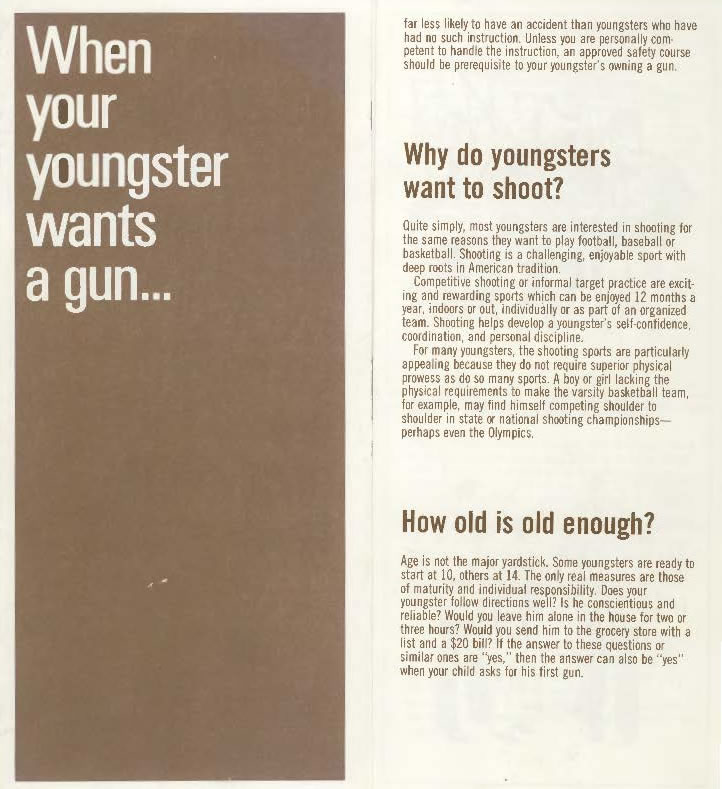
- At the NRA’s 1996 Annual Meeting in Dallas, Texas, then-President Marion Hammer introduced her 10-year-old grandson Michael, stating, “I know that when NRA reaches out and takes the hand of a child, we are touching America’s future.” Hammer also outlined the NRA’s agenda to “invest” in America’s youth, win their “hearts and minds,” and ensure the organization’s longevity: “I pledge to you to dedicate my term in office to two demanding missions. One is building an NRA bridge to America’s youth. The other is being fiscally far-sighted to provide for bold new programs that will teach America’s children values to last a lifetime. It will be an old-fashioned wrestling match for the hearts and minds of our children, and we’d better engage our adversaries with no holds barred….If we do not successfully reach out to the next generation, then the freedom and liberty that we’ve lived for ─ and that many of our ancestors have died for ─ will not live beyond us.”
- A New England Firearms advertisement that appeared on the cover of the September/October 1998 issue of the gun industry publication Shooting Sports Retailer warned, “It’s not ‘who your customers will be in five years.’ It’s `will there be any customers left.’” The cover shows a family shooting, with the parents slowly fading away as a child aims a long gun. Inside the magazine, a full-page ad from the company warns, “Building the next generation of customers takes work and commitment. But it must be done. The greatest threat to the firearms business may not be the anti-gunners. It is a future which lacks gun owners and users due to lack of interest. In effect, [the] greatest threat we face is the lack of a future customer base for the products which we all sell. Coming to grips with this challenge is not easy but it must be done.”6
The warnings made in the 1990s are being echoed in the new millennium. In a 2007 “Retailing Intelligence Report” column titled “Shooting for a New Audience” (subtitled “Reaching New Demographics is Critical to Our Industry”) in the gun industry trade publication Shooting Sports Retailer, industry marketing consultant Bruce Bear warned:
“If we don’t improve at cultivating new hunters and shooters, the sport we love and industry we work in will eventually die away. That’s a strong diagnosis, but a realistic one. Like many enthusiast sports in this busy, competitive world, people are leaving faster than new ones are coming in — and this is a recipe for industry-wide trouble down the road.“
Urging that the gun industry “Reach Out to Young Guns,” Bear warns, “It’s absolutely critical for us to pass a love of shooting and hunting on to the next generation,” and quotes a Dallas-area gun store owner: “Many baby boomers are getting older and getting out of hunting and shooting, and we need new people to replace them.” Adds Bear, “Working with kids and their parents is not only good business, it is helping families discover the fun of sharing shooting sports together.”7
The industry’s concern is easily understood looking at the demographics regarding not only hunting, but household gun ownership overall. According to the General Social Survey (GSS)8 conducted by the National Opinion Research Center (NORC) at the University of Chicago:
- From 1977 to 2014, the percentage of American households that reported having any guns in the home dropped by 40 percent.
- During this period household gun ownership hit its peak in 1977, when more than half (53.7 percent) of American households reported having any guns. By 2014, 32.4 percent of American households reported having any guns in the home, a drop of more than 20 percentage points.
- In 2014, less than a third of American households reported having a gun in the home.
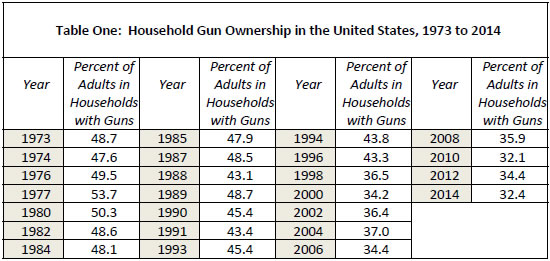
One of the “main reasons” cited by NORC for the decline in household firearms ownership is “the decrease in the popularity of hunting.” In 1977, 31.6 percent of adults lived in a household where they, a spouse, or both were hunters (see Table Two). By 2014 this number had dropped by more than half, to 15.4 percent.9

According to a survey from a 2015 National Shooting Sports Foundation marketing study, 72 percent of gun owners began hunting between the ages of six to 15 years old. After age 15, the percentages drop precipitously: 12 percent began hunting from age 16 to 20; three percent began hunting from age 21 to 25; and only six percent began hunting over the age of 25 (seven percent began hunting at age five or less). Recognizing that hunting is the primary means by which youth are introduced to guns, the focus on children is no surprise.10
The gun industry’s recognition that it relies on winning the “hearts and minds” of America’s children has not changed since NRA President Marion Hammer’s day. What has changed is the openness with which the industry and its lobbying partners carry out this mission, the lethality of the types of firearms they are promoting, and the sophistication of their marketing efforts to children. Bolt-action rifles are being supplanted by military-style assault rifles. Six-shot revolvers have given way to semiautomatic pistols. And just as before, a constant, underlying goal of this outreach effort is to ensure not just the financial well-being of the industry, but the political viability of the pro-gun movement.
While under federal law an individual must be 18 years old to purchase a rifle and 21 years old to purchase a handgun from a Federal Firearms License (FFL, the basic federal license required to deal in firearms) holder, federal law as regards possession is far more lax. Federal law is mute on long gun possession by those under the age of 18, and while federal law ostensibly prohibits handgun possession under the age of 18, there are numerous exceptions. State law on gun possession varies by jurisdiction.
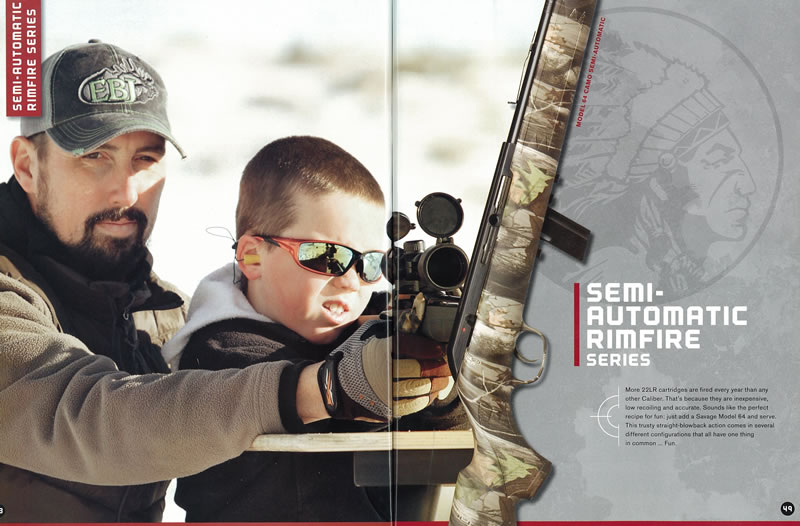
Davey Crickett, Little Jake, and the Marlin Man
Many Americans would be surprised at the age at which some parents introduce their children to firearms. This was made clear in April 2013 when a two-year-old Kentucky girl was unintentionally shot and killed by her five-year-old brother with a 22 caliber rifle he had received as a birthday gift. The gun, a Crickett rifle manufactured by Keystone Sporting Arms, the self-proclaimed “leading rifle supplier in the youth market,”11 is specially designed for children. On its webpage, a friendly cartoon character stepping into the Joe Camel role for the company, “Davey Crickett,” holds a rifle and stands atop the company’s slogan: “My First Rifle.”12 “Crickett Logo Wear” in the company’s catalog includes an armed Davey Crickett Beanie Baby (“not for children under three years of age”13), a Davey Crickett “trading pin,” and a “My First Rifle” dog tag. The company also has a promotional YouTube video for its child-sized weapons.14

On the company’s website, cartoon “story books” from Little Sportsman Inc. include My First Rifle as well as a series featuring a freckled-faced protagonist named “Little Jake” which includes the titles Little Jake and the Three Bears and Little Jake On Safari.
In Little Jake and the Three Bears, Little Jake decides he needs a bear rug for his bed to keep warm during the “long cold winter.” He then gets on his ATV, visits his friend the game warden to get his “bear-hunting license,” and then visits his “favorite sporting goods store” where his friend Jerry sells him the necessary “hunting supplies.” Little Jake then waits for bear hunting season to begin, “getting very excited” and noting, “It was almost like waiting for Christmas.” After coming across bears that were either “too small” or “too big” to keep him warm, he finds one that is “just right,” and shoots it, noting that the bear “never felt a thing.” The story ends with Little Jake in bed, covered by his bear rug, eating “tasty bear sausages.”
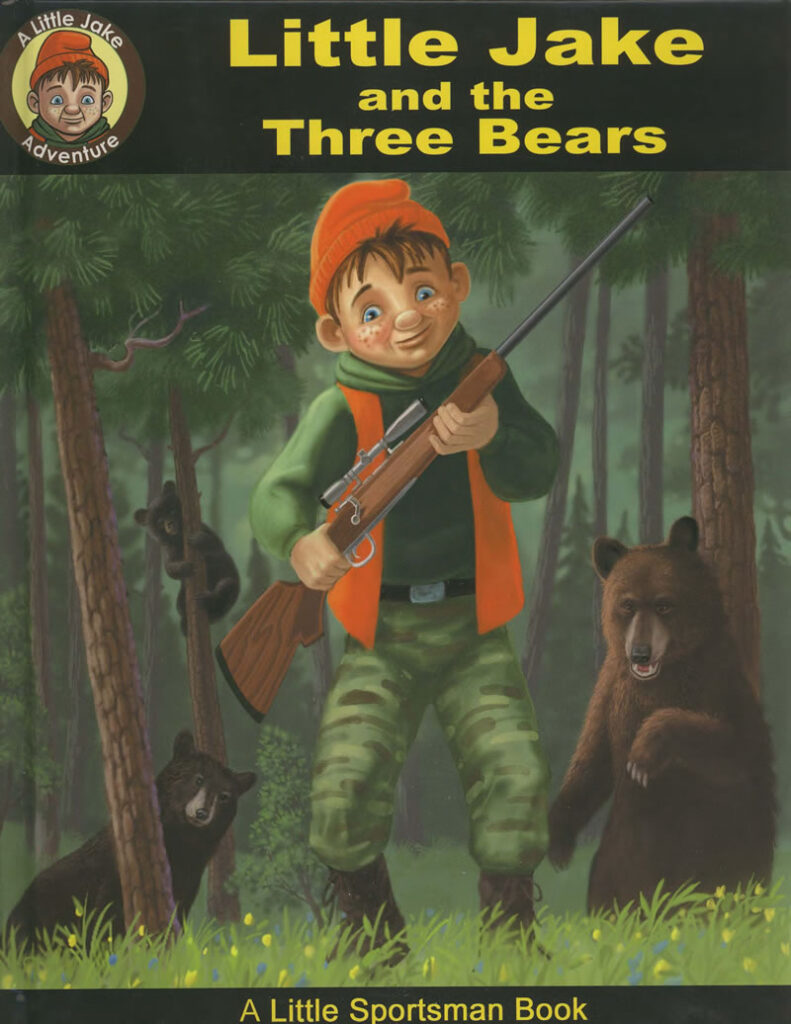
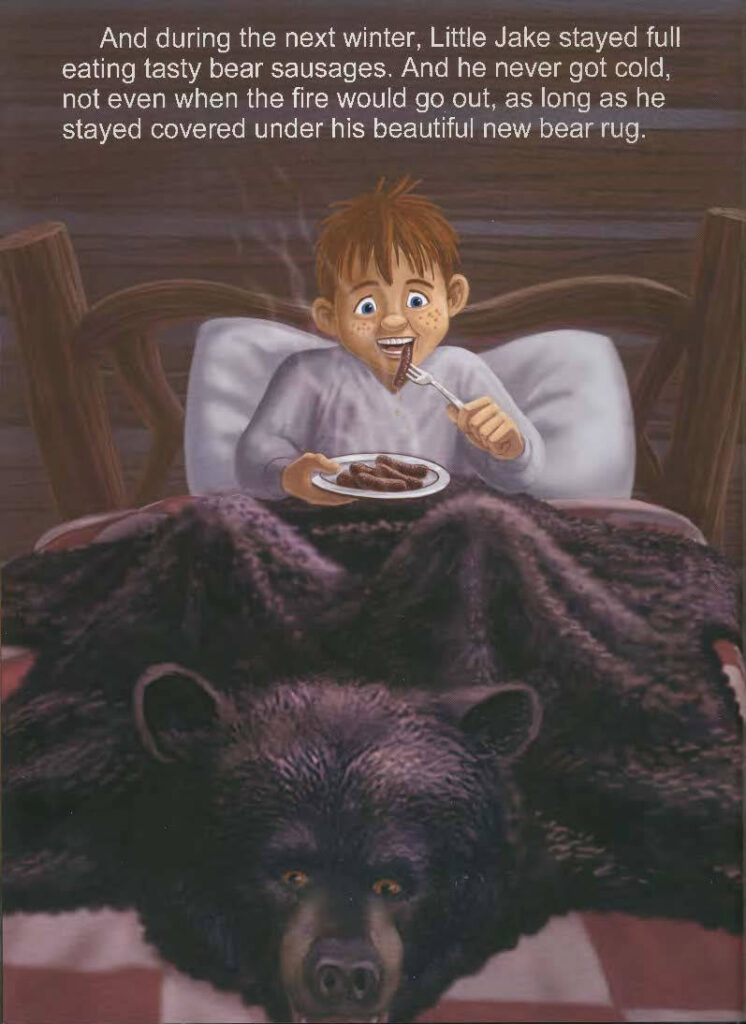
In Little Jake On Safari, Little Jake, his dad, and their hunting party interrupt their hunt for buffalo in Africa to aid a local village where there “has been a big bull elephant destroying their crops….” Little Jake and the hunting party go to the village, where they look over a scene of bent corn and smashed watermelons. After it’s explained to Little Jake that “These are not the cute, loveable animals you see in cartoons and at the circus” but “one of the smartest and most dangerous animals on earth,” the hunting party eventually comes across the elephant, who charges. Little Jake aims “for the brain” and brings the elephant down with two shots from his elephant gun with a “Bang!” and a “Bam!” The local villagers come, and before they start “harvesting the huge animal,” begin “singing and dancing around, happy that the elephant would never again destroy crops or hurt anymore [sic] people.” In the end, the tribe’s chief gives Little Jake the elephant’s tusks as a gift “so that you will always remember the time you saved my village.”
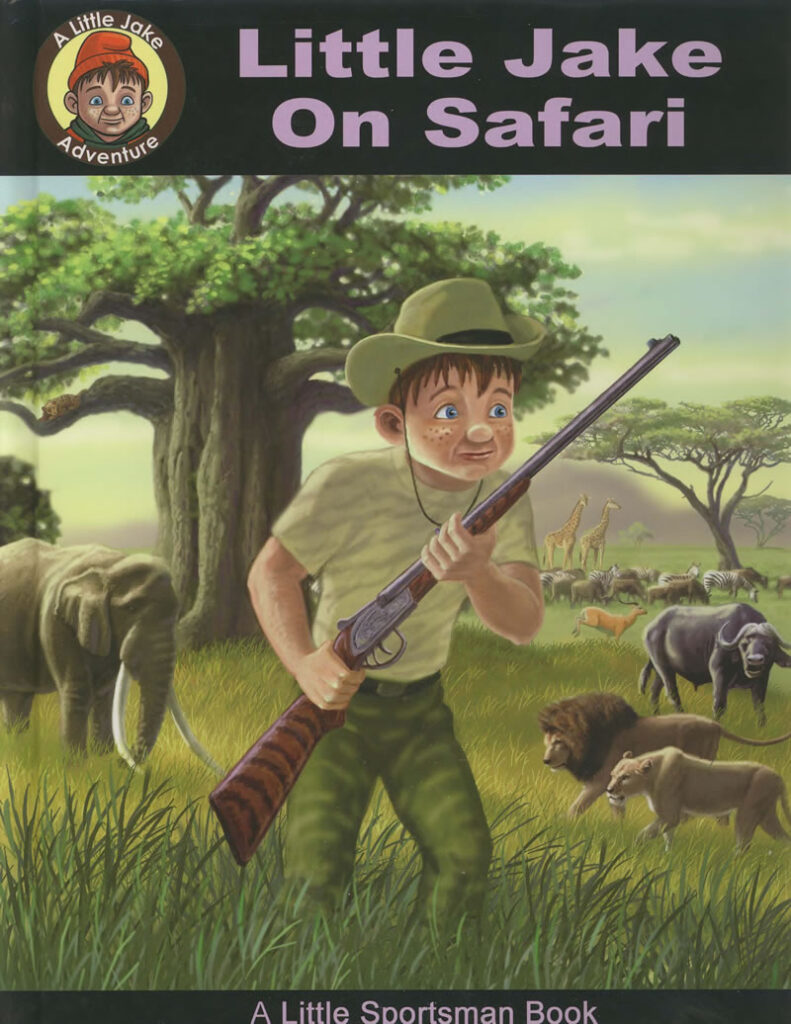

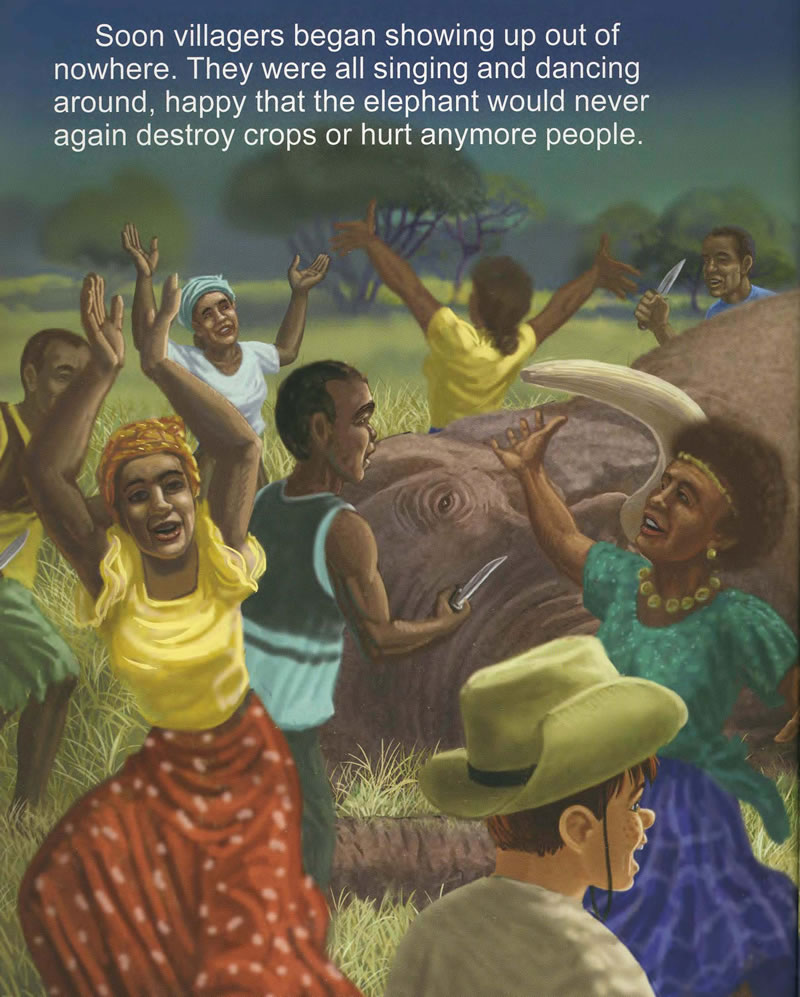
In a bizarre and brazenly transparent disclaimer, the publisher of the Little Jake series explains that even though Little Jake looks, talks, and acts “like a child”:
“Little Jake is a fictional character in his late teens. While small in stature so that young children may relate to him, Little Jake is old enough to hunt and fish safely on his own without adult supervision. As this series evolves with new titles, readers will learn more about Little Jake, his background and family. Soon we will be introduced to Little Jane (Little Jake’s younger sister) through her own book series.”15
Despite the presumed acceptability, and even desirability, of the combination of children and guns presented on the Keystone website, across the country, sorrow at the tragedy of the Kentucky shooting was followed by shock and surprise that not only could a five-year-old legally possess his own gun, but that there was a significant faction of the gun industry geared toward this market.
A 2014 article from NRA Family InSights on guns for children under eight years of age offers a snapshot of just one gunmaker’s efforts, Marlin, to target children, right down to the creation of a real-life “Marlin Man” by the company:
“There’s been a lot of talk about getting kids interested in shooting. Now, we’re finally seeing firearms manufacturers getting serious about it. Several companies are offering firearms sized just for kids. Marlin has taken a very bold step in that direction. They’ve done things right with their new XT line of .22 rifles. These rifles are not just sized for kids; they’re completely designed for kids.”
“Marlin took a different approach than many companies, which just put a shorter barrel on a rifle and cut the stock off a bit. Marlin engaged in a lengthy research program using real kids as test subjects. They looked at every aspect of a rifle in an effort to determine what they could do to make it more kid-friendly.”
“Their efforts paid off and in a big way. I got to see this first-hand at an event held at the Glade Springs Resort in West Virginia. Like many companies that launch a new firearm, Marlin invited several firearms journalists to come and see these new rifles. But this time, Marlin went a step further: They asked the writers to bring their kids.”
“This made perfect sense, because what better way to evaluate rifles sized specifically for kids than to let kids shoot them? Before the event got underway, the kids spent the morning riding horses. And then, when they arrived at the range, they got to meet the Marlin Man and his horse in person. The Marlin Man is the mounted cowboy Marlin has used as a logo for many years. He was brought to life for the kids at this event and he stirred the cowboy in everyone present.”
“The kids were turned loose on the range, which was staffed with Marlin employees and members of the West Virginia Division of Natural Resources. After two days of shooting thousands of rounds of .22 LR ammunition, the verdict was in: Marlin’s XT 22 Youth rifles are winners. If you’re a kid looking for your first rifle, this is the gun you need to tell your parents about.”16
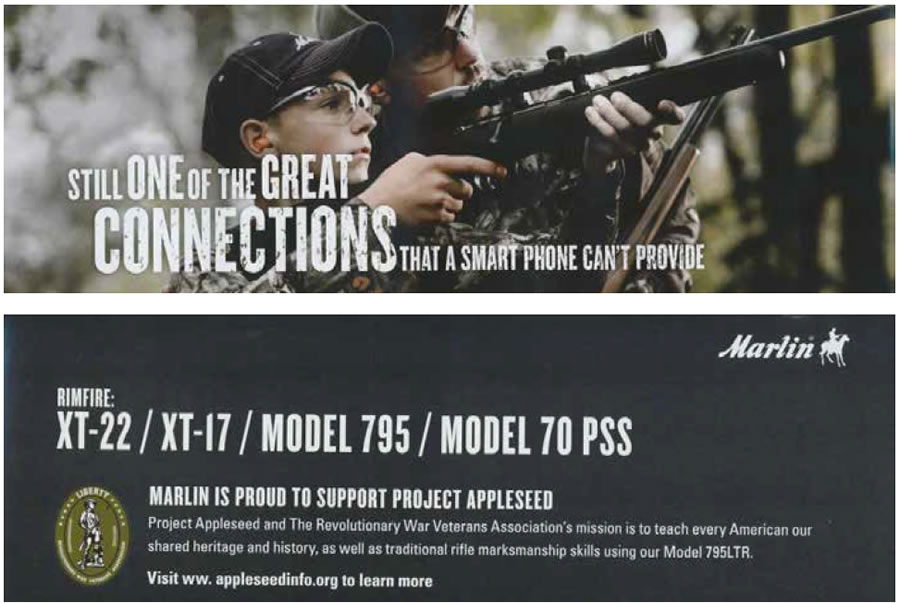
“Tactical” Rifles For Kids and Guns in a Rainbow of Colors
From gun magazines, to websites, to social media, two things become clear. For some gun owners there is almost a race to the bottom to see how young a child can be to handle, and eventually possess, a gun. At the same time, there’s not infrequently an inverse trend to see how powerful a gun the child can handle.
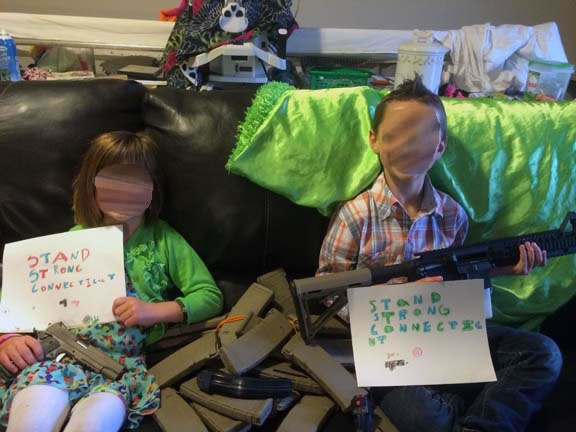
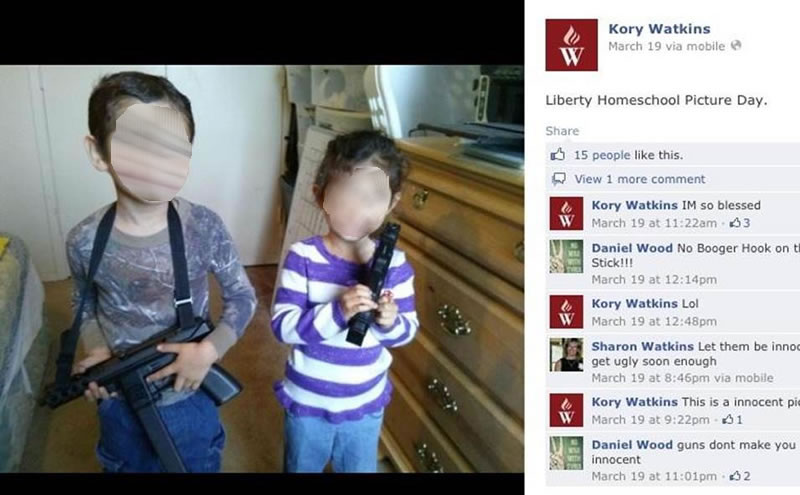
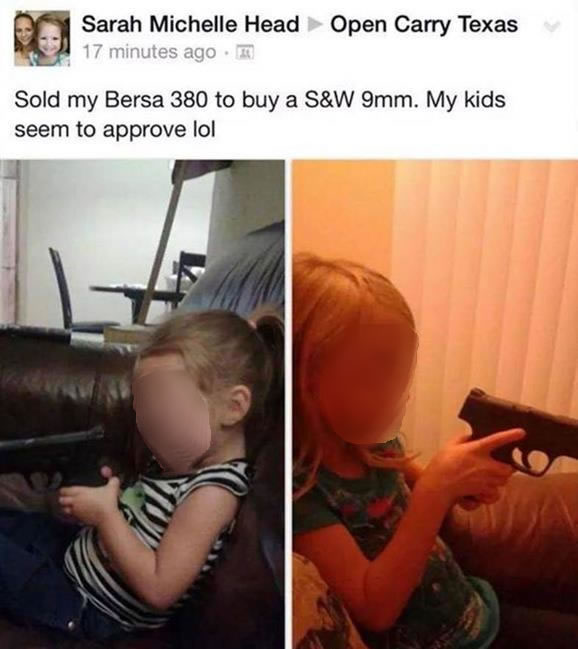
Writing for Jews for the Preservation of Firearms Ownership (JPFO) in 2014, JPFO writer contributor Nicki Kenyon explains:
“When my son was 4 years old, we decided it was time to introduce him to gun safety. He couldn’t quite tie his shoes yet, but we knew we had guns in the house, and we knew we needed to instill good habits early, because it was literally a matter of life and death. His father was a police officer, and I was active in gun rights, and made it a point to be armed as much as possible. I still do. It’s a matter of life and death….”
“I can’t remember how old he was, exactly, when he shot his first firearm – I think he was probably 8 years old – but I know he was around 10 when he shot his first machine gun. I remember when he was about 6 years old, I sent him to my bedroom to get some paperwork that was on his father’s night stand. He called down to me and said, ‘Mommy! Daddy’s pistol is sitting on top of the paperwork. Do I have your permission to move it?’ That’s when I knew we taught him well….”
“My son was lucky. He was legally allowed to handle firearms in Virginia. We took him to the range. He shot a variety of firearms – rifles, pistols, machine guns and shot guns. He has had his own eye and hearing protection since he was in elementary school, and he received his first Mossberg Plinkster when he was approximately 9.”17
And while Kenyon describes her child’s climb up the ladder of firepower with equal doses of pride and rationalization, four months later the risks of putting a full-auto machine gun into the hands of a child was illustrated to the nation with horrific clarity. On August 25, 2014, 39-year-old firearms instructor Charles Vacca, a father of four, was shot and killed at the Last Stop gun range when he was teaching a nine-year-old on vacation with her family in Las Vegas how to shoot an UZI submachine gun. The girl lost control of the weapon as the result of the full-auto weapon’s recoil. The gun climbed up out of her control and she unintentionally shot Vacca in the head. The girl then dropped the weapon and ran to her family, who huddled around her as she held her shoulder.18
In the comments section of an online article from the NRA’s American Hunter magazine titled “Choosing Your Child’s First Gun,” readers detailed the ages at which they felt their own sons and daughters were ready for their first gun: five, six, seven, and older. One of the points raised in the article was the fact that the recoil from many guns can hurt child shooters. As a Virginia Beach gunsmith told the author, “The first thing you want to avoid is to not overgun your kid…You try to give an 8-year-old kid a .308 or some blowaway magnum and it’s going to be too much. It will just make the child recoil shy and that’s the worst thing you can do to a kid.” The author added, “Not only will it hamper their ability to become accurate, but it may chase them away from the sport before they’ve even really had the chance to get into it, according to many experts. Every time they shoot, they’ll be thinking, ‘this gun is going to kick the heck out of me,’ and if that thought is on their mind, they’ll never be able to shoot accurately.”19
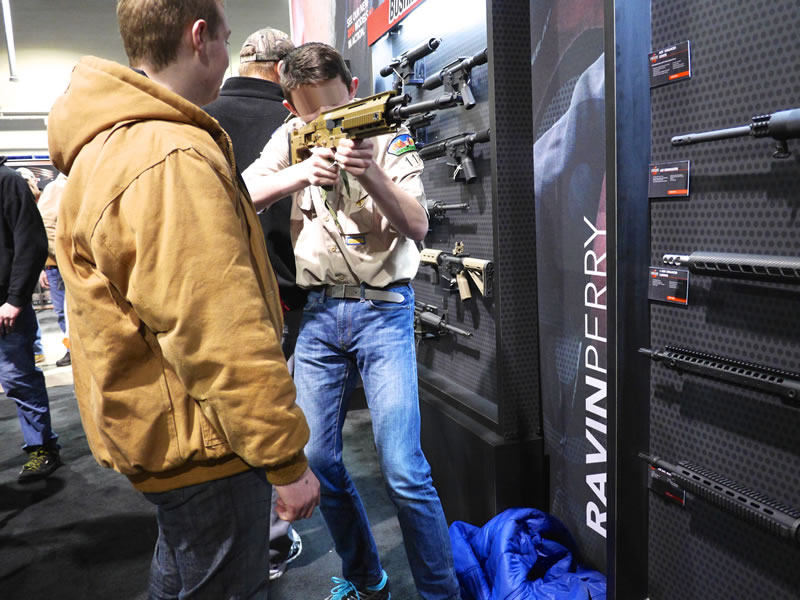
One reader did take issue with the author’s reticence on recommending an AR-15 assault rifle as a first gun for an eight- or 10-year-old child, writing, “If you teach your child proper firearms basics an AR is the perfect way to go. I built my six year old son one and he loves it.”20
For those who don’t want to wait to put an assault rifle in their children’s hands, but do have concerns about recoil and the weight of the weapon, a growing industry-wide trend toward 22 caliber assault rifles, often utilizing plastic resulting in lighter weight, has taken hold and is expanding. An additional frequently cited benefit is the relatively low cost of .22 ammunition, particularly for those who wish to train with the weapon.21 As one author noted in Shooting Sports Retailer in discussing 22 caliber AR-style assault rifles: “these guns bring the coolness and fun of the tactical rifle to kids and less serious shooters….”22 Throughout the industry, 22 caliber versions of higher-caliber assault rifles are increasingly common and frequently cited in the context of marketing guns to children:
- The product description for a .22 Bushmaster AR-15 model at the Gander Mountain Sports website states: “Designed for the indoor range and the youth shooter, this Carbon15 .22 LR Rimfire lightweight is sure to add new dimensions to your Bushmaster shooting pleasure. Operational controls are functionally and ergonomically identical to AR-15 type rifles….”23
- “INTRODUCING THE NEW SIG522 Rifle” says a Sig Sauer ad for a new 22 caliber assault rifle that appeared in the Summer 2011 edition of Junior Shooters. [see later section Junior Shooters: “For Kids By Kids”] Under the headline “DOUBLE TAKE,” the text reads, “It looks like the legendary SIG556, but look again. It’s the SIG522 Rifle firing affordable .22LR. The new SIG522 has the look, feel, and action of the classic military-style SIG556 rifle…yet it costs much less, and fires affordable .22LR rounds. The full-size semi-auto SIG522 features a button rifled barrel with flash suppressor, light weight aluminum receiver with integral Picatinny rail, Swiss-style folding stock, and a 25-round magazine. To find out more about how to get the look, feel, action, and dependability of the SIG556, combined with .22LR caliber affordability, check out the new SIG522 at www.sigsauer.com – on the double!“ [Emphasis in original]24
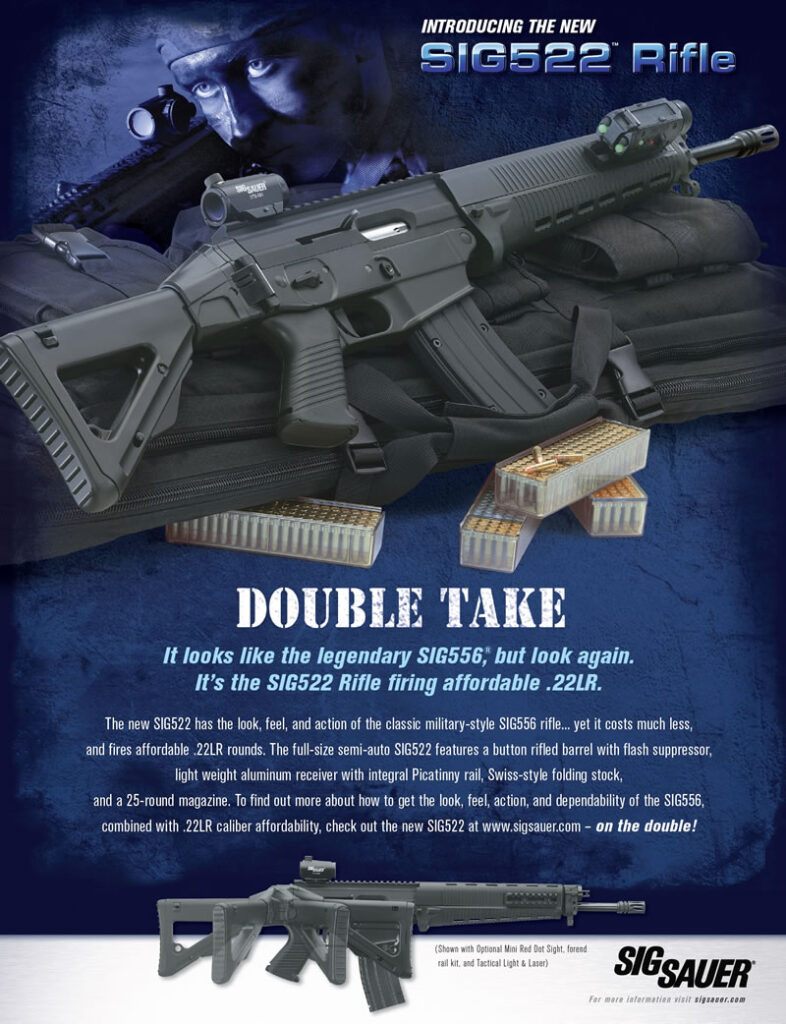
- An article in Junior Shooters exclaims, “One of the best dedicated AR-type .22 rifles to come out in the last couple of years is Smith & Wesson’s M&P15-22. The M&P15-22 is built with high-strength polymer upper and lower receivers. This creates a reduced-weight rifle that retains the looks and operating features of the standard M&P rifle. Let me tell you, this rifle rocks!”25
- A December 2013 review published on the website of Bill’s Gun Shop & Range promises that the “Beretta ARX 160 in .22 LR is the company’s fun version of their current military carbine that was designed in 2008. The military versions come chambered in 5.56x45mm NATO, 5.45x39mm Soviet, 6.8mm Remington SPC and 7.62x39mm Soviet. Along with the Italian Army it is also being fielded by Albania, Egypt, Kazakhstan, the Mexican Federal Police and Turkmenistan. The U.S. was in the process of evaluating it as a replacement for the M4 before the replacement process of [sic] cancelled.” At the end of the glowing review, the shop concludes, “December is the perfect month for Bill’s to offer this carbine as their Gun of the Month as plenty of kids (both young and old) will have a military replica .22 on their Christmas list. The Beretta ARX 160 is a great choice and the holiday gives you the perfect excuse to buy one and act like it is a gift for your son or daughter. Just be sure to bring them to the range and let them shoot it every once in a while.”26 Surrounded by candy canes, a bow, and ribbon, the assault weapon is the gun dealer’s “December Gun of the Month.”

The appeal of the Beretta assault rifle to youth was made clear at the 2014 NRA-sponsored Great American Outdoor Show in Harrisburg, Pennsylvania. At the Beretta display at the show, a constant stream of young children, some alone, others accompanied by their parents, were drawn to the models of the gun, as well as other Beretta assault weapons, as these photographs of the Beretta display at the show illustrate.

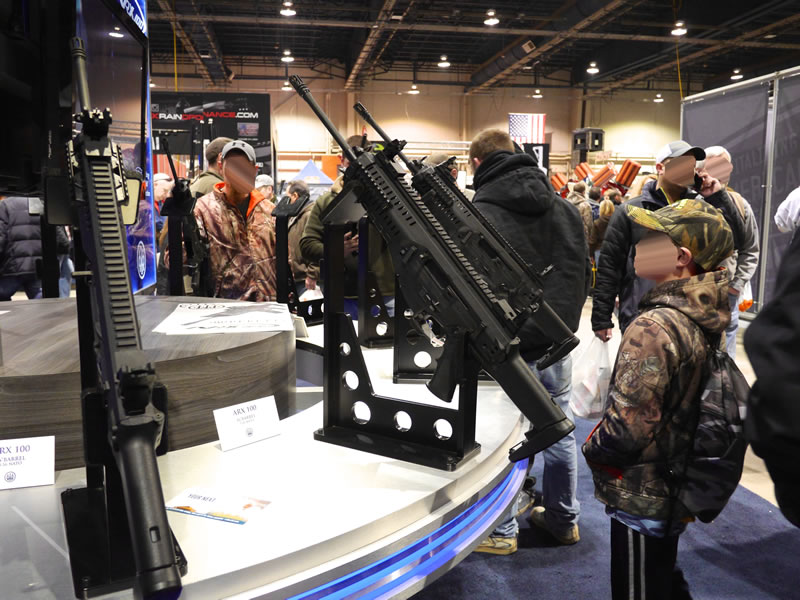

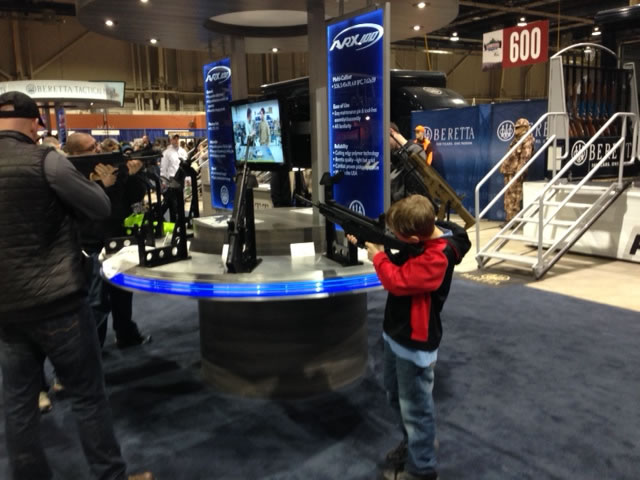
In an Instagram photo from the 2019 gun industry show of new firearms that is the centerpiece of the National Rifle Association’s annual meeting, assault rifle manufacturer Anderson Manufacturing says, “It’s been a pleasure hanging out with our loyal customers of all ages.” In the photo, two boys who are “part of the Anderson family” hold AR-15 style assault rifles.
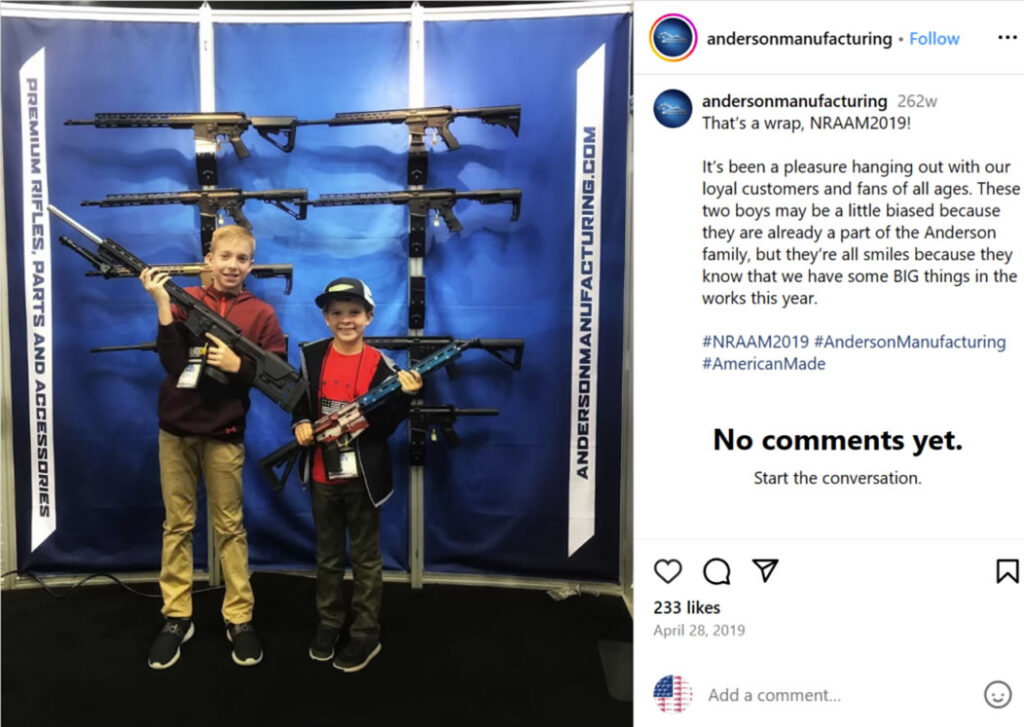
At the January 2022 SHOT Show (Shooting, Hunting, Outdoor Trade Show, the annual-closed-to-the-public trade show for the gun industry), Illinois-based gun manufacturer WEE1 Tactical promoted a line of AR-15 assault rifles designed specifically for children. Dubbed the JR-15, the company explained that the child-sized assault rifles were 20 percent smaller than a standard AR-15, weighed only 2.2 pounds, and came with a retail price of $389. The company promised that the children’s assault rifle “looks, feels, and operates just like Mom and Dad’s gun.”
WEE1’s website and related materials (including hats, patches, and stickers) were dominated by cartoons of a skull and crossbones of a boy and a girl (see below).

The boy skull had a blonde mohawk haircut and a green pacifier and the girl skull had blonde pigtails with pink bows and a pink pacifier. Both had one eye a black void and the other a rifle sight.
On its website, under the headline “SWAG,” the company boasted, “The BRAND is meant to be EDGY. We believe its [sic] exciting and will build brand recognition and loyalty!” In an official SHOT Show “Product Spotlight” video profiling the gun, WEE1 Tactical’s Eric Schmid explained that the logo, “Keeps the wow factor with the kids.”

After the Violence Policy Center focused press and policymaker attention on the gun and its accompanying marketing campaign, a public uproar followed. As a result, the company soon dropped its “edgy” marketing and its website was reduced to a query contact form. Publicity surrounding the company’s sales efforts resulted in California and Illinois passing laws banning the marketing of guns to children.
Yet the cancerous effects of this marketing effort were already being seen. That July, U.S. Rep. Marjorie Taylor Greene (R-GA) disturbingly suggested in a tweet – which contained a picture of then-House Speaker Nancy Pelosi next to a blow-up of advertising material for the JR-15 as she spoke against the gun on the House floor – that the students attacked in the May 2022 Uvalde, Texas school shooting “needed JR-15s to defend themselves” against the shooter. The attack, which occurred at Robb Elementary School and was carried out with a Daniels Defense DDM4 V7 AR-15 style assault rifle, left 21 victims dead and 17 wounded.
By the 2023 SHOT Show WEE1 Tactical was back, having adopted a supposedly ‘kinder, gentler’ marketing approach in response to the backlash the company had faced over the past year.
In a new flyer, the “wow factor” graphics for “the kids” were gone, replaced by a little girl pointing the assault rifle toward the reader with her “Parent or Coach” by her side. The company no longer promoted the gun as a child-size AR-15 but instead stated that the gun “functions like a modern sporting rifle” ─ the gun industry’s self-generated euphemism for military-bred assault rifles. Characterizing the guns as “a small piece of American freedom” representing “American Family Values,” the company promised that the “JR-15 is the first in a line of shooting platforms designed to safely help adults introduce young enthusiasts to the shooting sports.” According to new website (which unlike its predecessor now required visitors to attest that they were 18 years of age or older as a result of the new laws generated by the gun’s initial marketing efforts), “WEE1 TACTICAL is now taking orders for the JR-15.”
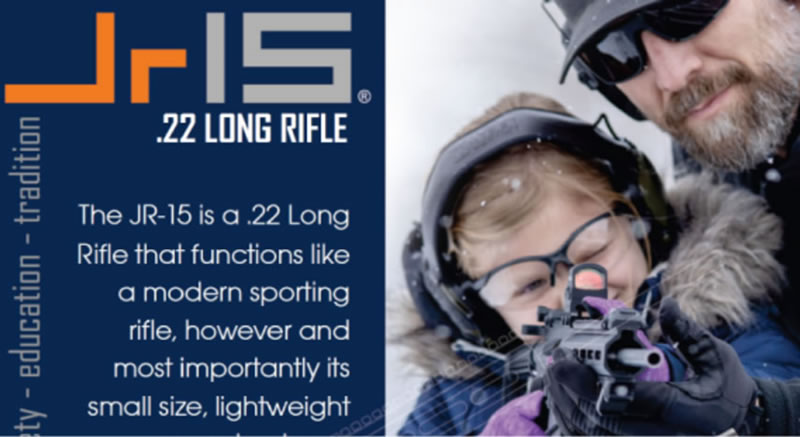
Apparently, there weren’t enough orders. By the 2025 SHOT Show the founders of WEE1 Tactical were back with an apparently new company, Mountain Billy Gun Lab, and what appeared to be the same junior-sized AR-15 assault rifle – but with a new name: The GOAT-15. (It was however, still characterized as a “small piece of American freedom.”) This third-try wolf-in-sheep’s-clothing marketing effort promoted the GOAT-15 as “The Lightest AR Style Firearms in the World…Meticulously designed for those with an active lifestyle looking for a lightweight, compact gun to carry while hiking or camping.”
But dreams die hard. And while the overtly grotesque child marketing of past years was gone, the company now embraced the more veiled coded language for youth marketing (i.e. “beginners”) that’s common in the gun industry.
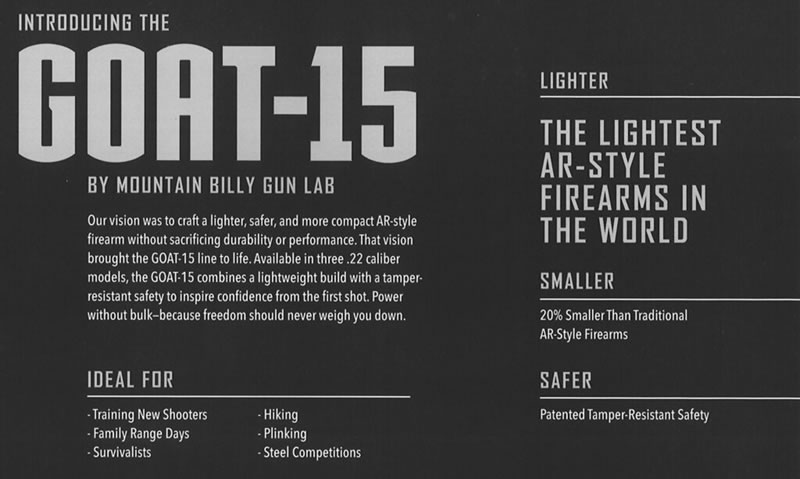
According to the company’s website, “The GOAT-15 has been praised in the firearms community as the “ideal training gun” while being “great” for “first time shooting” and “family range days.” A blog on the company’s website states, “Its smaller frame is perfect for those with a smaller stature, including many women and young adults.”
A second blog, under the subhead, “Introducing the GOAT-15: A Perfect Choice for Beginners,” states, the “GOAT-15 .22 long rifle from Mountain Billy Gun Lab stands out as an exceptional choice, especially for beginners.” The blog adds, “The ergonomic design ensures a comfortable grip, and the intuitive controls make it easy to handle, even for someone with little to no experience.”
In addition to the GOAT-15 Helium rifle ─ “the lightest semi-automatic rifle in the world” ─ the company has also added an assault pistol, the GOAT-15 Atom pistol. The company promises the handgun “offers comfortable handling and an ergonomic design for confident shooting at any level. Compact, reliable, and ideal for hikers and survivalists, it’s the perfect addition to any adventure.”

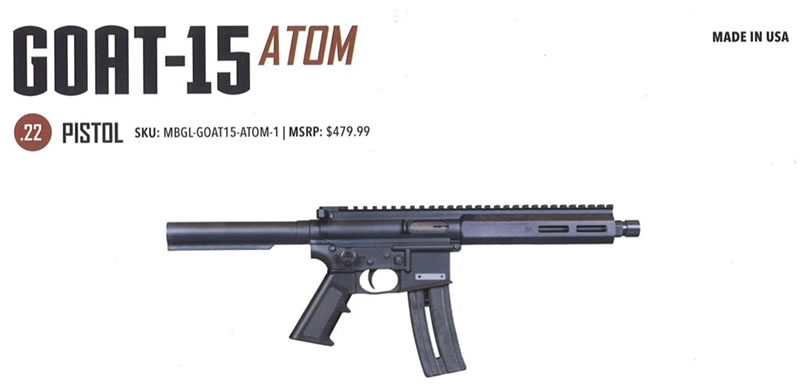
Guns in a Rainbow of Colors
According to Shooting Sports Retailer, “More companies are offering pistols, rifles and shotguns built for smaller-framed shooters these days, with a dizzying array of models, colors and calibers to choose from. Making sure your customers get the best fit could help bring the next generation into the shooting sports.”27 The article, “The Best Guns for Smaller Shooters,” warns:
“So for reasons both fiscal and political, it’s critical to provide products well-suited to young shooters. Although these guns have traditionally been called “youth models,” when we started looking at the current offerings, we saw many called “compact” versions instead. This implicitly points out that while we’re using age as our primary qualifier, the features that make a gun well matched for young people also help the gun fit other shooters who are small of stature, such as females.”28
“Lenin was famously quoted as saying “Give me just one generation of youth, and I’ll transform the whole world.” With this in mind, developing the next generation in the shooting sports isn’t just a business decision: The survival of the firearms world depends on the political will of those who come after us, which is a direct result of their involvement in the shooting sports.”

Most common are pink guns for women and girls. At the online Sportsman’s Outdoor Superstore, potential buyers can browse “Guns with Color,” which includes pistols, revolvers, rifles (including numerous assault rifles), and shotguns. Under pink pistols are weapons from Beretta, Browning, Cobra, Kel-Tec, SCCY, Ruger, Sig Sauer, Taurus, and Walther. Pink guns for females are a key marketing tool for girls:
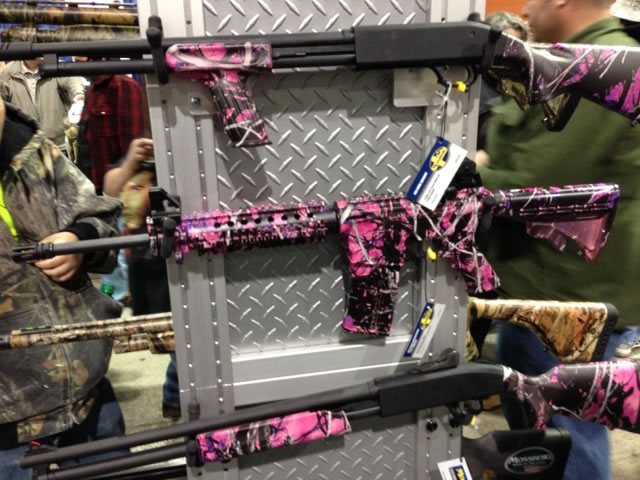
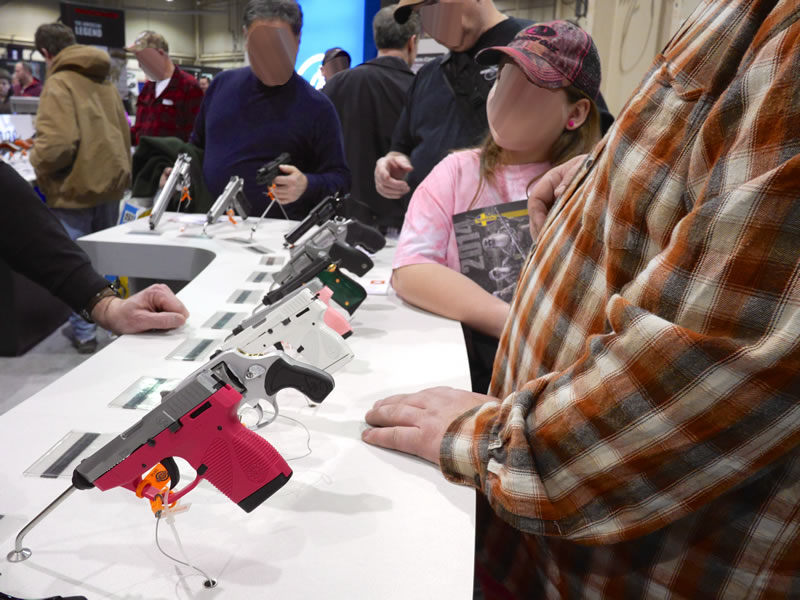
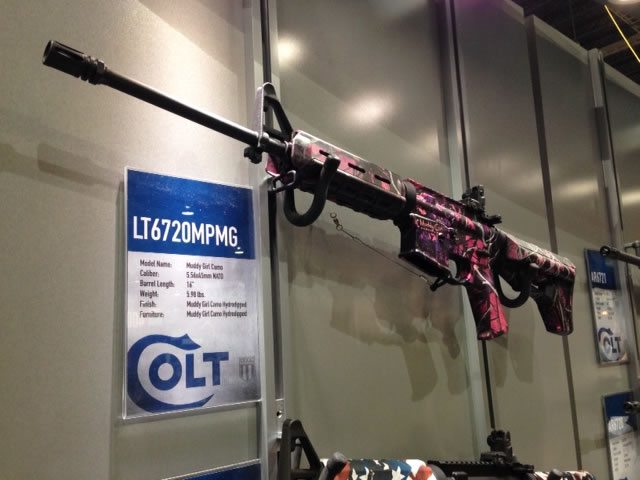
“When 8-year-old Sara saw the gun, she knew she wanted to shoot it. Even though she’d never shot a gun before in her life and had never shown an interest in shooting, once she took a look at the ‘Muddy Girl’ from Henry Repeating Arms, she wanted to take her first shot.
“New in 2014, this Henry mini-bolt rifle, called the Muddy Girl, sports its namesake’s camo pattern — a zany hot-pink-purple-and-black combination that belongs on more guns than just this little wonder. It makes a lifestyle statement for females that says, ‘This gun is mine. Get your own…
“Sara, a ‘girly-girl’ who likes to cheerlead, left her pompoms behind, yet still coordinated her pink-and-black matching apparel for the photo shoot. Out on the range, her Aunt Marti — a pro-staffer for Mossy Oak and Moultrie Products…showed her how to shoulder the gun and how to weld her cheek to the curvy, synthetic stock…
“’I like the color and the size of this gun,’ said Sara. ‘And I also like that it didn’t kick me and it was easy to use…’
“Its one-piece synthetic stock has been designed with just the right angle for little hands to grasp the gun firmly and still pull the trigger with confidence.”29

Writing in Junior Shooters magazine, 12-year-old Casey Lutz is featured with a pink CZ bolt-action youth rifle. Says Lutz: “When my dad brought home the gun, a CZ 452 Scout, chambered in 22 long rifle, I was excited to see that the gun was pink! My first thought was, ‘Finally, a cool gun for a girl!’ It’s nice to see that companies like CZ make guns specifically for young women shooters. The second thing I noticed was the gun was small and compact and was designed to fit kids.”30
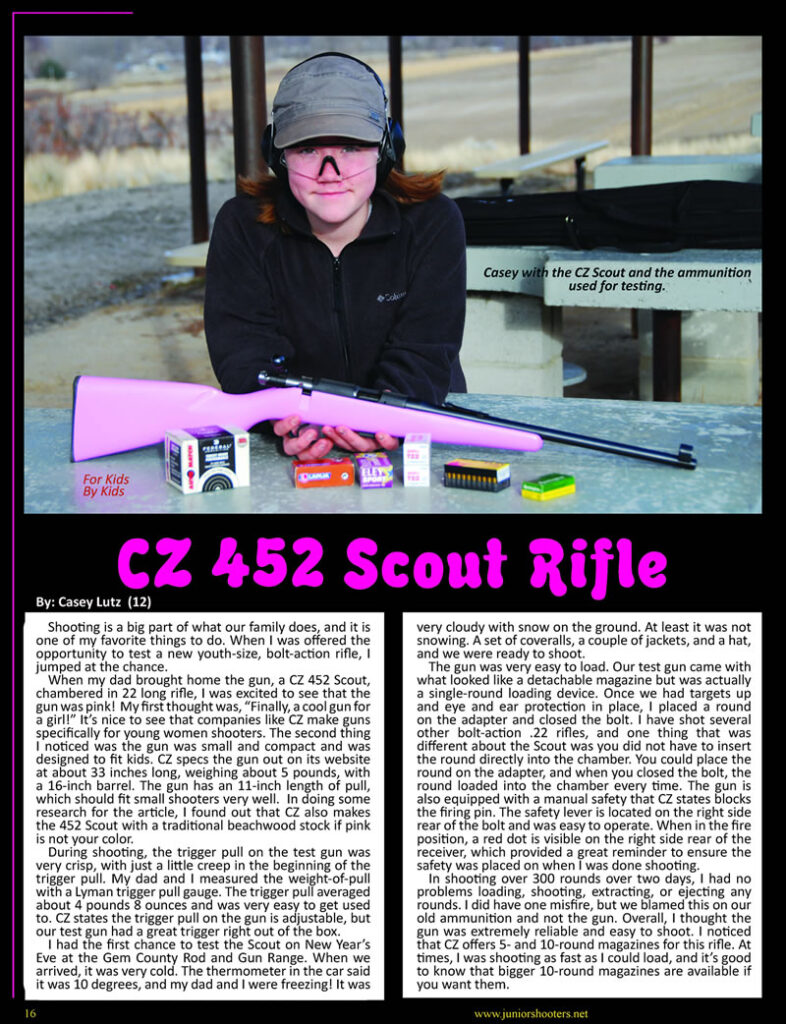
A crayon-box of colors is offered for guns specifically targeted at youth, including the 22 caliber weapons through which they are most likely to be introduced to shooting.
- Smith & Wesson offers a 22 caliber version of its M&P15 (M&P stands for Military & Police) AR-15 assault rifle in bright colors that include Pink Platinum, Purple Platinum, and Harvest Moon Orange.31
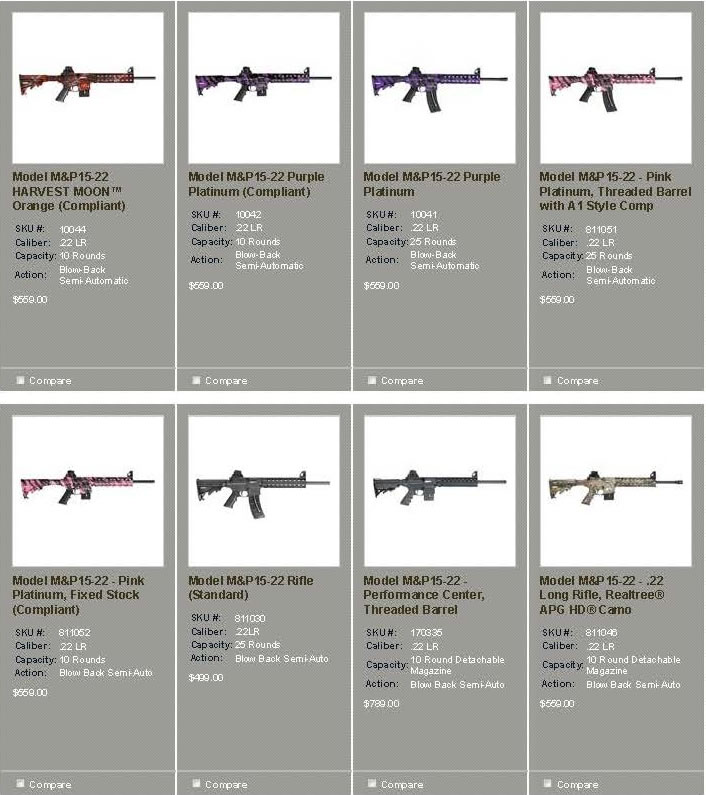
- Savage Arms’ youth rifle, the Rascal, presents the gun in child-friendly colors: red, yellow, orange, pink, and blue. In an ad for the youth rifle, the company promises that the firearms deliver “ONE SHOT, ONE THRILL !”

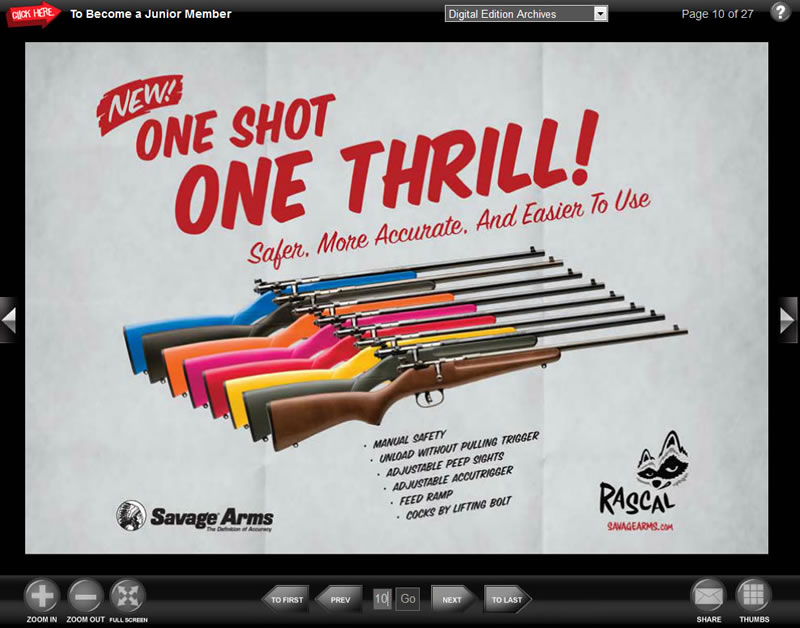
- On its website, featuring assault rifles “built by Americans, for Americans,” Black Forge Weapons offers “Youth Model” AR-15 assault rifles that come in orange, violet, green, blue, and red.32
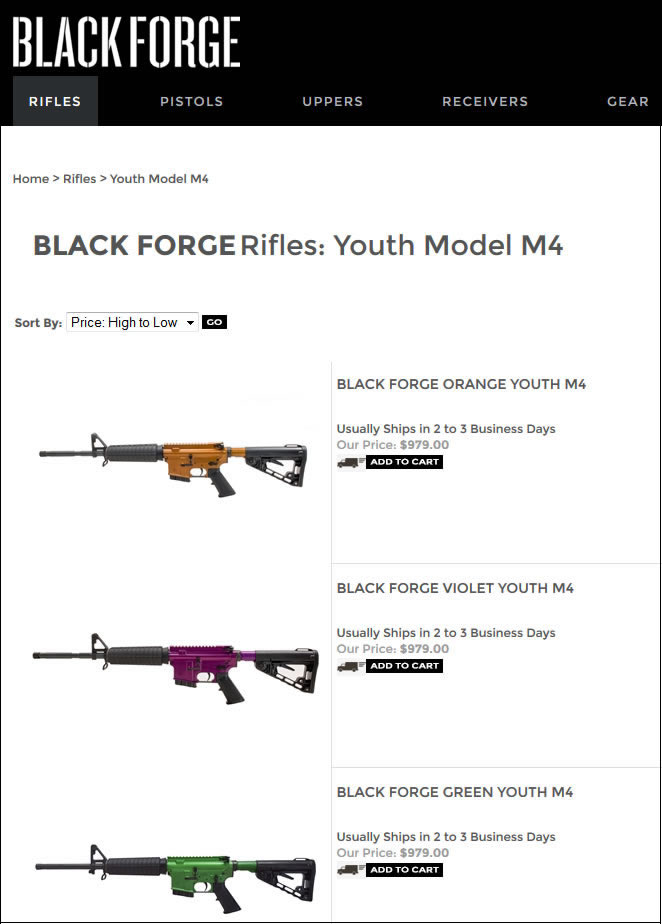
“Fiscal and Political” Benefits of Marketing Guns to Children
As noted by Shooting Sports Retailer, the impetus for marketing to children is both “fiscal and political.”33 In addition to the hoped-for financial benefits of marketing guns to youth, a corollary goal is to ensure that such an effort will help maintain a pro-gun base for political action.
Writing in the NRA’s America’s 1st Freedom magazine, Editor Mark Chesnut warns that “the future of our freedom – and our shooting and hunting heritage – lies in our children and grandchildren. Let’s not get too busy or too focused on ourselves and our own activities to pass along to our kids the important things they need to know in order to be informed citizens and voters in the future.”34
In a Spring 2012 editorial, Junior Shooters Editor-In-Chief Andy Fink chided those gun industry members who, when urged to target youth, respond, “Oh, that isn’t my market?”35 Noting that it’s not just an issue of jobs, but of “gun rights,” he warns:
“It is thrilling to see so many people supporting juniors around the country. People are volunteering their time. Companies and organizations also provide time, energy, products, and money to ensure the shooting sports continue. However, we are not doing enough. All the companies involved in the shooting industry need to realize our youth are the future of the shooting industry and thus each job within the industry is dependent upon juniors growing up with an appreciation for the sport we love. Each adult needs to help in some way by volunteering, or promoting youth shooting. This effort will also have a huge impact on retaining our gun rights, our hunting heritage, and wildlife conservation. We all need to do our part.”36
Later that year, Fink revisited the issue:
“Each person who is introduced to the shooting sports and has a positive experience is another vote in favor of keeping our American heritage and freedom alive. They may not be old enough to vote now, but they will be in the future. And think about how many lives they will come in contact with that they can impact! Each of us affects others, and it is up to us how we make an impact on the future.”37
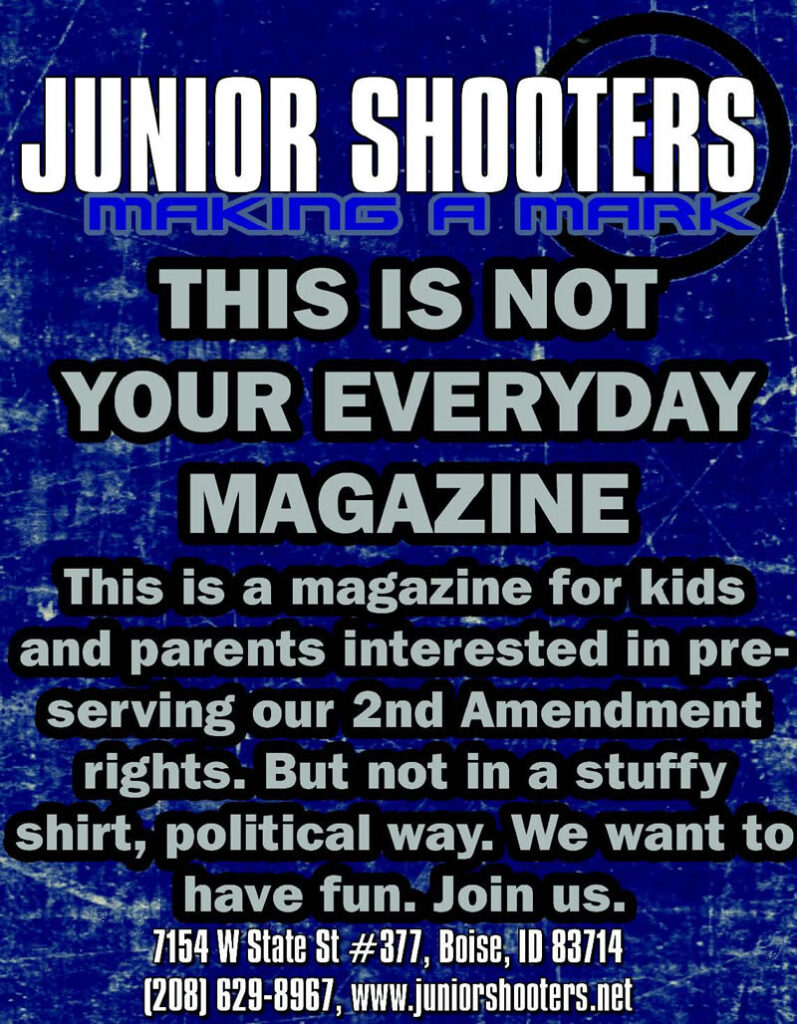
Or, as a Junior Shooters promotional ad for itself in the magazine cheerfully explained under the headline “Junior Shooters: Making a Mark” — “This is not your everyday magazine. This is a magazine for kids and parents interested in preserving our 2nd Amendment rights. But not in a stuffy shirt, political way. We want to have fun. Join us.”38
And in an article on the National Shooting Sports Foundation’s 2015 gun industry summit, Shooting Sports Retailer stated:
“And of course, the problem with failing to recruit and grow is that numbers equate to political power. In an era when the private ownership and use of firearms, the right to “keep and bear arms,” has come under increasing pressure, numbers and a young, vital membership are critical.”39
Junior Shooters Magazine and NRA “Junior Members”
Perhaps the most honest and unvarnished look into the ongoing effort to create a youth gun culture can be found in Junior Shooters, available online and in print format.
Based in Boise, Idaho, the magazine “strives to be the first of its kind to promote juniors involved in all shooting disciplines…” and is “dedicated to juniors of all ages and their parents.” The publication adds, “We care about kids and their parents and want you to have a place to go to find what is needed to get started in many different shooting venues.”40
Visitors to the website are greeted by ads for AR-15 assault rifles. Clicking on the Rock River Arms ad for its LAR Coyote Carbine, the viewer is taken to a full description of the weapon on the company’s website, and the ability to explore the full site. An ad for Stag Arms shows an AR-15 assault rifle and in a series of panels asks the questions “LEFT HANDED?” “RIGHT HANDED?” “WE’VE GOT YOU COVERED!” Clicking on the ad brings you to the company’s website.41

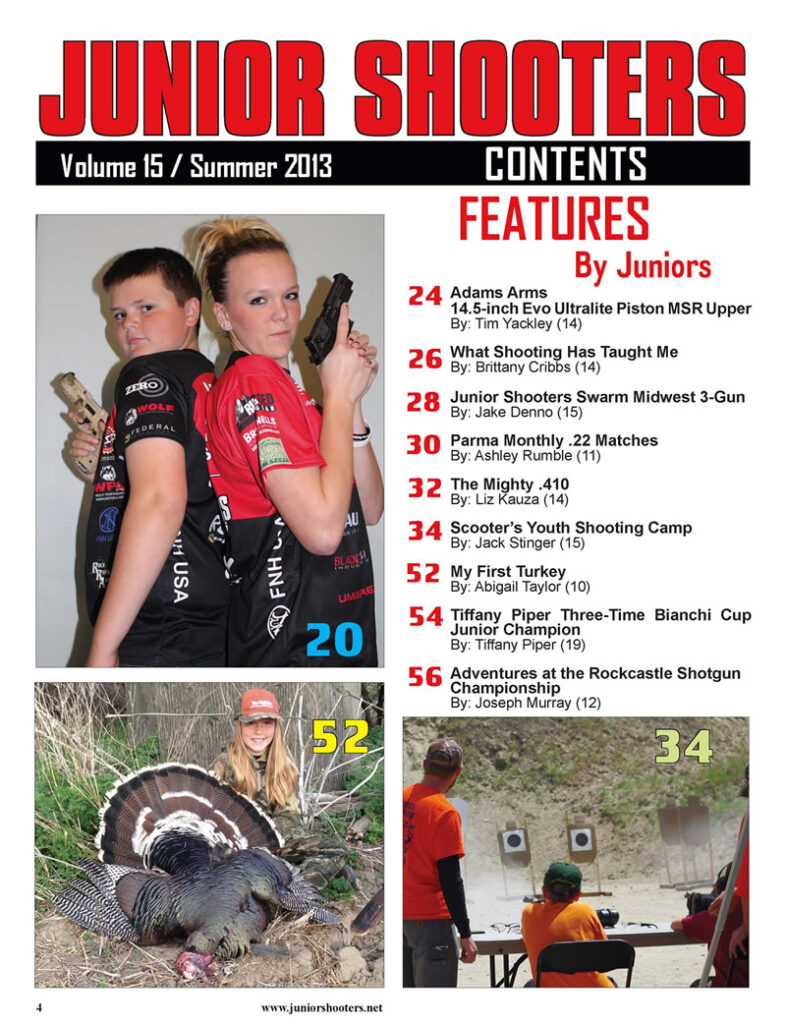
Additional gun manufacturers listed as sponsors on the website are: companies that manufacture only assault weapons, such as Bushmaster (manufacturer of the AR-15 assault rifle used in the 2012 Sandy Hook Elementary School shooting in Newtown, Connecticut that left 20 students and six educators dead) as well as the aforementioned Rock River Arms and Stag Arms; companies that manufacture assault weapons and high-capacity pistols, such as FNHUSA, Remington, Sig Sauer, Smith & Wesson, and Sturm, Ruger & Company; and, companies that manufacture solely pistols, such as Glock.42 Each issue of Junior Shooters contains an Advertiser’s Index at the back of the magazine. Among the associations listed as sponsors of the publication is the gun industry trade association the National Shooting Sports Foundation (NSSF) and National Rifle Association Youth Programs.
Little known outside of pro-gun circles, the magazine frequently presents a blunt view of the financial and political benefits that recruitment of children offers the pro-gun movement.
In discussing the benefits of “junior shooters” to the gun industry and gun lobby, Editor-In-Chief Andy Fink explains, “Juniors start shooting, and become interested, in related sports at a young age, as young as six, seven, or eight” and can continue as “junior” shooters until the age of 18 or 21, adding, “They may also have the build of a young youth or an adult.”43
Fink makes the case that literally every firearms product can be marketed to “juniors,” including concealed carry pistols (with the goal of the youth eventually obtaining a concealed carry permit when old enough) and assault rifles, writing:
“What market isn’t tied to juniors? I really can’t think of any. Military and law enforcement firearms have civilian versions which are applicable. The Concealed Carry Weapon (CCW) market has firearms which hold 10-rounds which is the limit for IDPA [International Defensive Pistol Association] competition.44 When the junior turns 21 they can get a CCW permit. What do they buy? It is usually a gun from a manufacturer they are familiar with.”45
Promising content “For Kids By Kids,” articles in the magazine, with headlines such as “Why I Love Bushmaster AR-15s…You Should, Too”46 commonly promote high-capacity semiautomatic pistols and assault rifles, often referred to by the industry-promoted euphemism “Modern Sporting Rifles” (MSR). At the same time, advertisements for assault weapons, high-capacity semiautomatic pistols, and firearm accessories are ubiquitous. Examples of the types of weapons and accessories promoted for children and youth in editorial content and advertisements are offered below.
- A 2014 press release from gun manufacturer Mossberg included with online articles on the Junior Shooters website boasts that the company has “45 Firearms Developed Specifically for Smaller-Statured or Younger Shooters.” The self-proclaimed “leader in the development and design of firearms for younger and small-statured shooters,” the company touts its “recently-launched Mossberg 2014 Youth Catalog” and lists among its “industry-partners” the National Shooting Sports Foundation and the National Rifle Association.47
- A profile of an AR-15 assault rifle upper receiver states that the “Adams Arms 14.5” Evo Ultralite Piston AR-15 upper is a great upper for a junior shooter; it’s light, it’s short, and it’s accurate.”48 “One advantage to having such a short, light upper is maneuverability and ease of use by younger, smaller shooters. At one local 3-Gun match [see the later section, The Industry Finds Its “’Reality’ Video Game” in 3-Gun Competition], there was a long hallway with four doorways that you had to shoot through. The targets were set up so you had to move into the doorway. The short barrel really helped me move in and out of the doorways quickly. It was a real advantage.”49
- In a 2009 article that comes across more as a promotional piece, “The Mosquito: A Cool .22 With A Sting,” Editor-in-Chief Andy Fink writes, “The .22 Mosquito is a real stinger.” Spread across the top of the page is manufacturer Sig Sauer’s logo. At the bottom is a picture of the pistol in pink, with the caption “The pink Mosquito – For the ladies!” Promising that the pistol’s “slide is easy to operate even for youngsters,” in the article Fink tests the gun, as do children ages 11, 12, 14, and 16. Fink reports, “Each of them liked the feel of the gun and operation. They had to get used to the first shot cocking the hammer being double-action with a heavy trigger pull of 12.1 pounds.”50
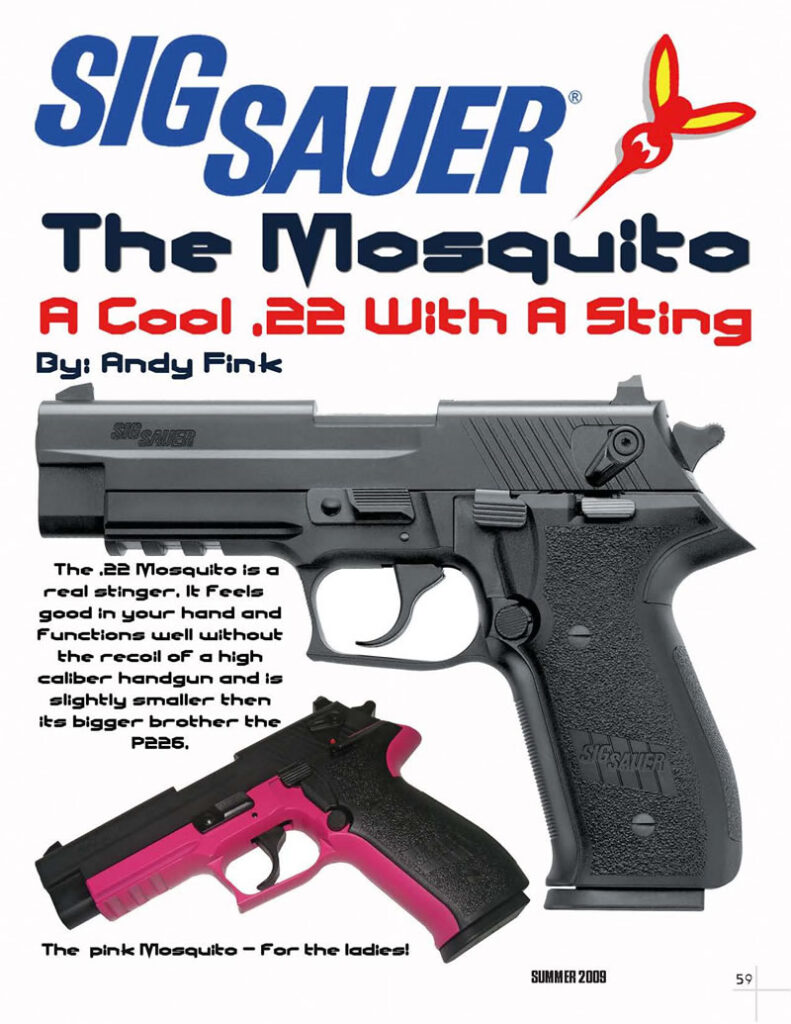
Four years later, Fink revisited the gun, this time with three co-authors, two age 13 and one 18 years old:
“This pistol is sweet! It looks cool. It fits in your hand well, even the small hands of juniors and smaller women. It’s a double/single-action semi-auto and is great for plinking and practice…51 Sig Sauer’s Mosquito has an ergonomic design to provide an enjoyable shooting experience. It is based on the design of the Sig Sauer P226 but is 10% smaller in size and chambered for the .22 long rifle cartridge.”52
In the article, endorsements for the pistol are offered by two 13-year-old boys:
“Hayden Lierman (13): My .22 Mosquito pistol is the Desert Digital Camo model manufactured by Sig Sauer…The pistol looks cool and feels like a Beretta, which I think is awesome. It’s a desert camouflage color.”53
“Wyatt Irish (13): At first I thought that it was way too small to be reliable…However, one thing was for sure: I loved how the grip felt in my hand. For a person with small, bony-fingered, 13-year-old hands, the grip almost felt custom fit.”54
- In “Glocks are for Girls,” the magazine reviews “a small, compact pistol” that is “generally used for conceal carry.” The reviewer notes that “because of its small frame, I was able to shoot and operate it easily despite having small hands.”55
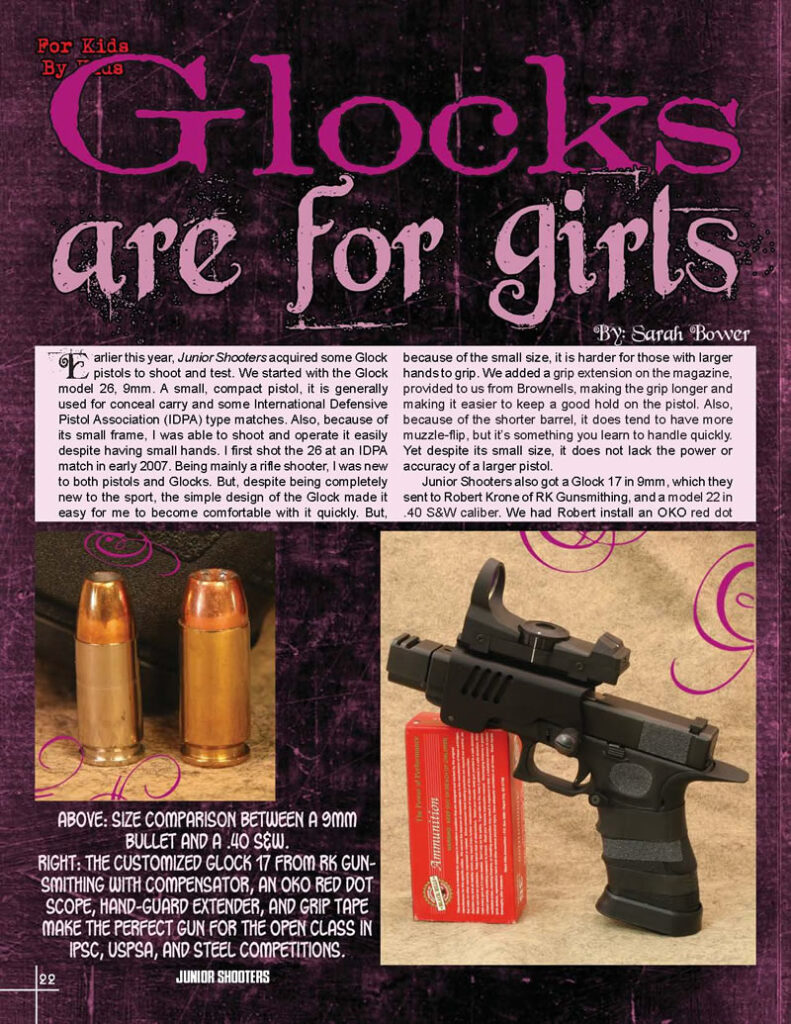
- Under “Kids’ Gear” the magazine promotes online shooting sports accessories marketer Brownells (headed by NRA Board Member Pete Brownell) and features an assault rifle with a 100-round ammunition magazine:
“WOW! Do you need shooting accessories to go with your firearm? What about optics, mounting equipment, slings, magazines, cleaning materials, and parts? Brownells carries just about anything you can imagine…Junior Shooters has been working with Brownells since it started publication. We have found them to [sic] very supportive of promoting juniors and the shooting sports, and their customer service is excellent! We seriously recommend you check them out at www.brownells.com.”56
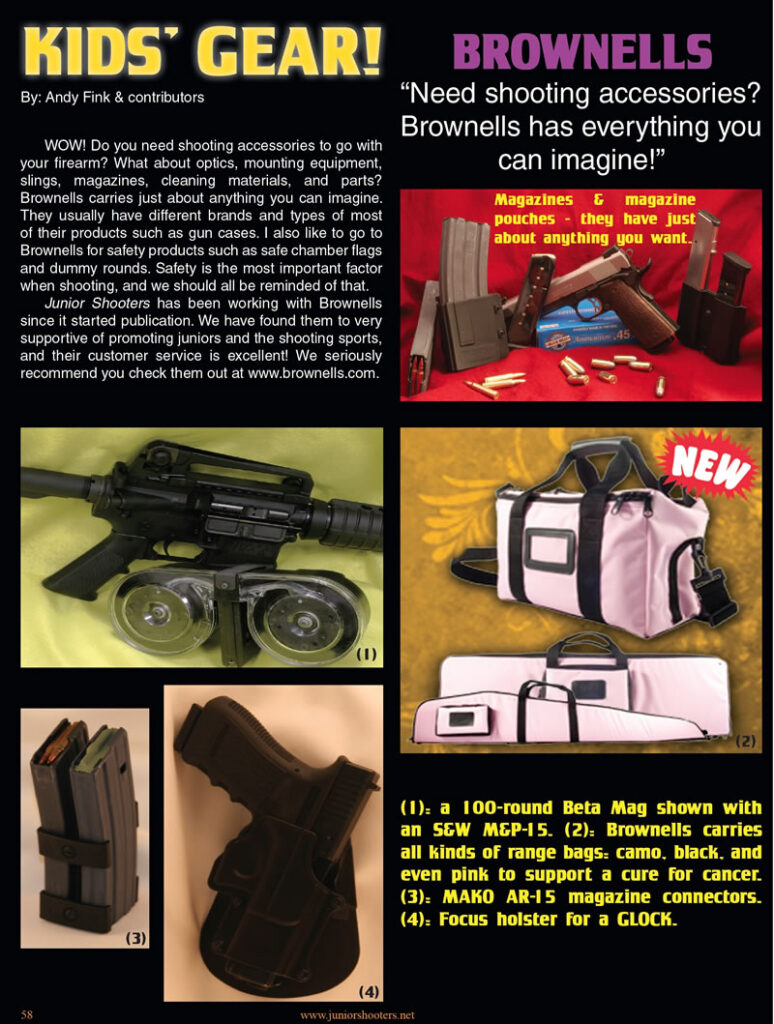
- “FIREFIELD SALUTES YOU, JUNIOR SHOOTERS!” is the headline atop a full-page ad from parts and accessories manufacturer Firefield. Below two males dressed in camo, one holding a shotgun and the other brandishing a pistol, the text reads:
“We know that you are tomorrow’s leaders of the industry, the ones who continue to value and support the outdoors through shooting. The one’s [sic] who will continue to uphold the values of our country. The one’s [sic] who will introduce the value of the great outdoors to the next generation and instill in them the love and respect that comes with being a shooter. Firefield isn’t all about winning. We know the real victory lies in getting out there, smelling the fresh air and holding freedom in your hands. Let’s keep that victory for the next junior shooters.”
The ad ends with “Firefield – Victory Justifies Everything!”57
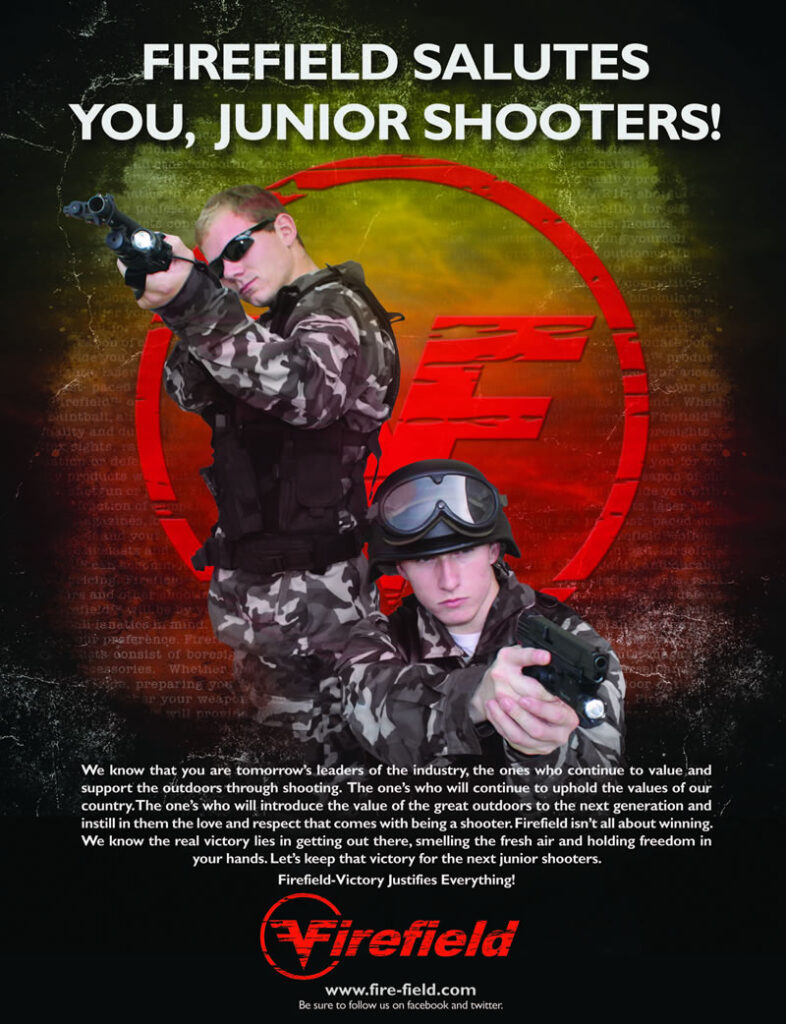
In addition to the implicit advertising benefits Junior Shooters’ articles “For Kids By Kids” offer the gun industry, the magazine regularly features full-page ads from gun companies, many featuring assault rifles and high-capacity pistols:
- A full-page ad from Next Generation Arms for its X7 AR-15-style assault rifle states: “The Gray Rifle – an indistinct, shadowy weapon carried by an unseen, unstoppable foe.” The ad continues: “Who is the X7 for? Visit us at www.nextgenerationarms.com and look at some of our featured users. They train many thousands a year in the tactical use of the AR-15. They protect and serve. They defend their homes and their homeland. The X7 continues our tradition of tactical performance and better-than-needed accuracy in a military grade small shoulder arm that works in all climates with little care.”58
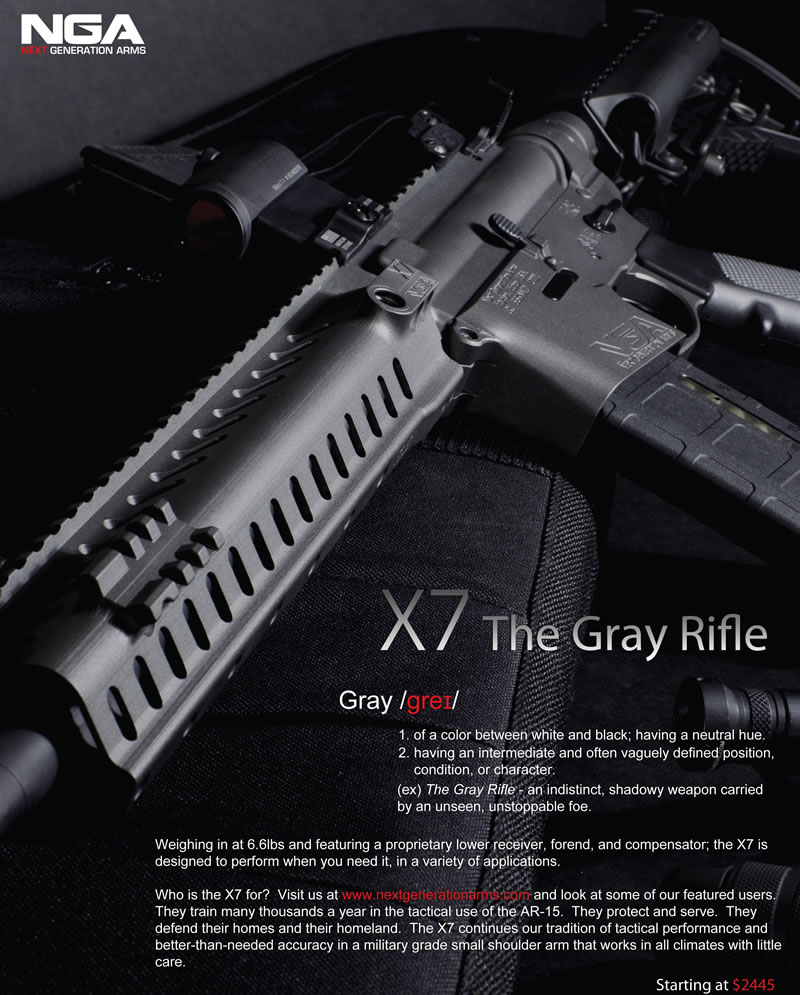
- An ad for a 22 caliber 1911 pistol has the headline “Make Dad Jealous” with a smiling young girl holding a target as the centerpiece. The text reads, “For less than $300, you can own an authentic 1911 reproduction in .22 LR and spend the day shooting and improving your skills – without emptying dad’s wallet. Available through your local gun shop.”59

- A full-page ad from Stag Arms features an AR-15-style assault rifle with a high-capacity ammunition magazine and promises that the gun is “Adaptable To Any Application.”60
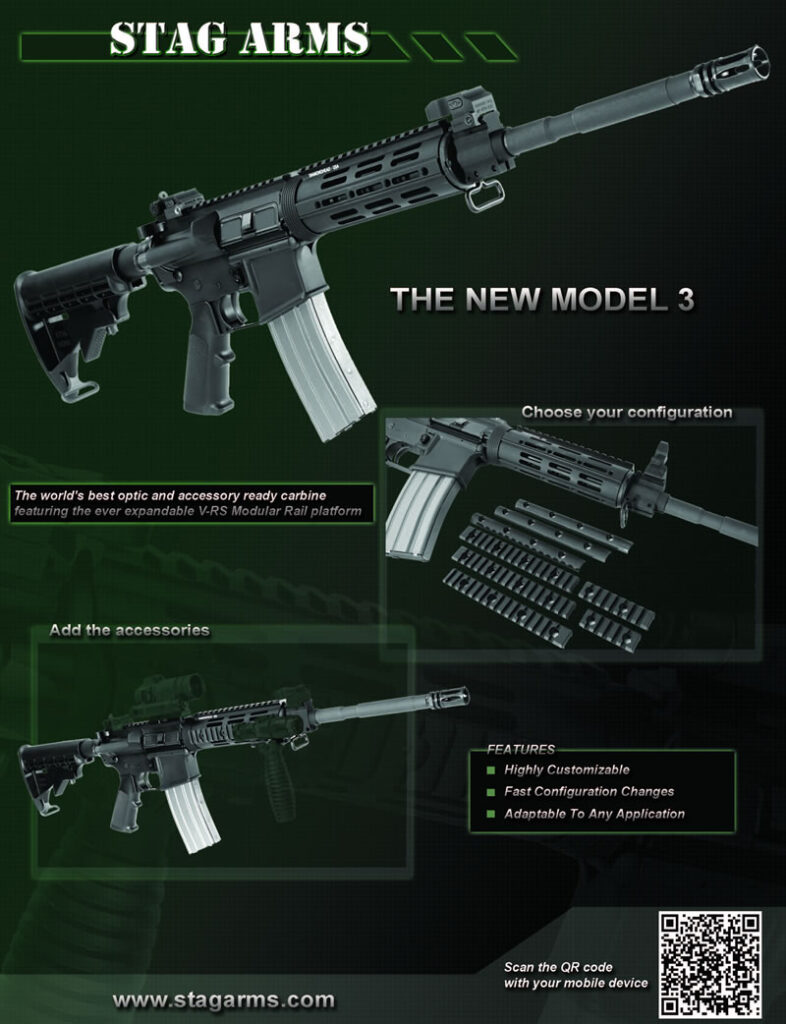
- A full-page ad for Glock pistols shows two black males, a youth and an adult, at an outdoor range, with the headline “Confidence to Live Your Life.” The ad, in which the youth is holding an ammunition magazine in one hand and a round in the other, states, “Shooting the best pistol means you can hone your skills and rise to any challenge. Backed by proven reliability, superior engineering and used by approximately 65% of law enforcement, GLOCK is a partner you can trust.”61
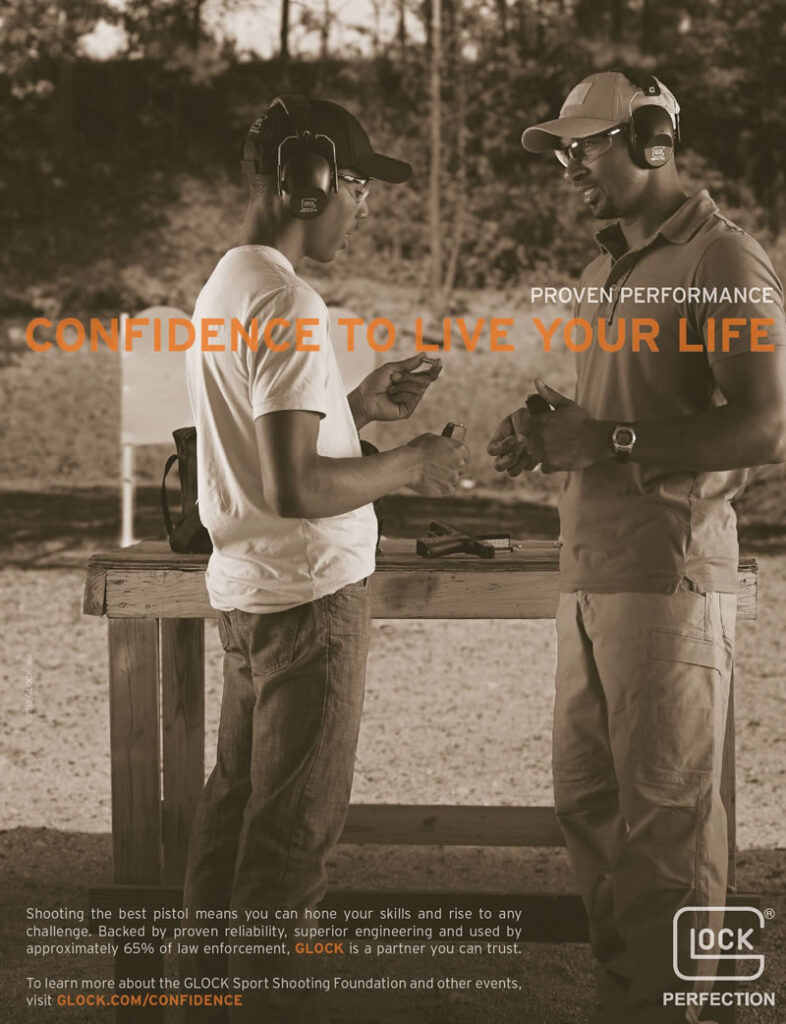
- An ad for Rock River Arms’ LAR Series of assault rifles (which come in Varmint and Predator models) states, “From varmints to vermin, predators to prey, RRA LAR-8 Series Rifles.”62
- A full-page ad for Sig Sauer’s SP2022 pistol features the handgun, notes that it comes in 9mm, .357, and 40 caliber and adds, “No wonder it’s becoming the standard choice among elite military and LE [law enforcement] forces worldwide.”63 A second full-page ad from the company for its “microcompact” P290RS concealed carry pistol states, “Get 9mm performance in a palm-sized, easy-to-carry polymer package.” The tag line for the ad states, “Sig Sauer, when it counts.”64
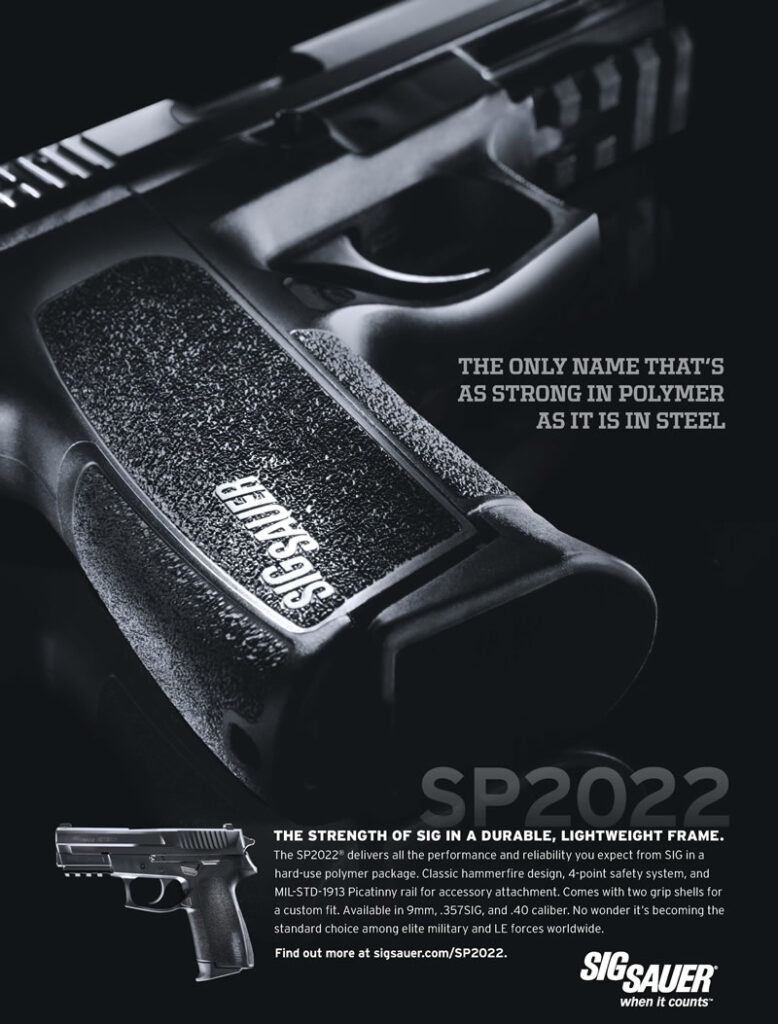
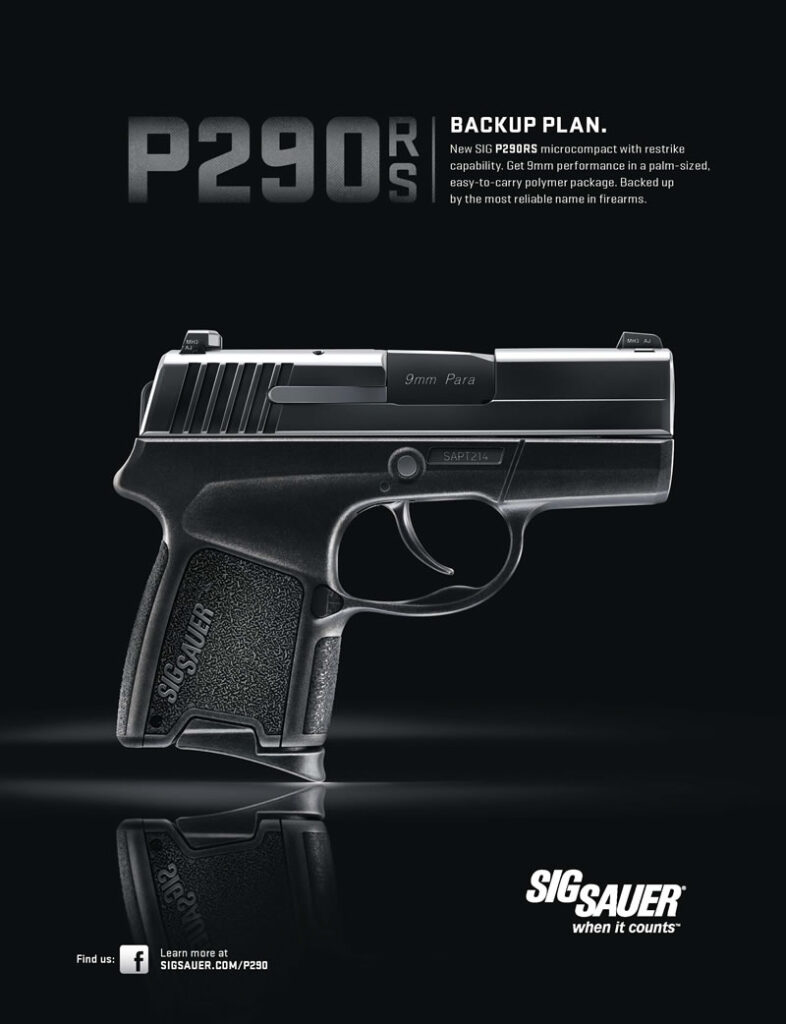
NRA “Junior Members”
Since 1981, and until recently, the National Rifle Association has published in print or online NRA InSights magazine for its Junior Members65 under the age of 15 (although the online content is available to anyone).66
The industry’s focus on youth as its financial savior is made clear in an ad for Marlin’s XT rimfire rifle that appeared in the online version of the magazine. The headline of the ad reads, “FOR THE FUTURE OF OUR SPORT, IT’S THE MOST POWERFUL FIREARM ON EARTH.” With a picture of a father and son together, the ad promises that the gun can “light a fire for the shooting sports or rekindle your own.” Clicking on the ad leads the reader to the company’s website and its full product line. Another online ad, for the Kel-Tec PMR-30 pistol, links to the company’s website, where the first three images that greet the reader are adult shooters holding assault rifles.67
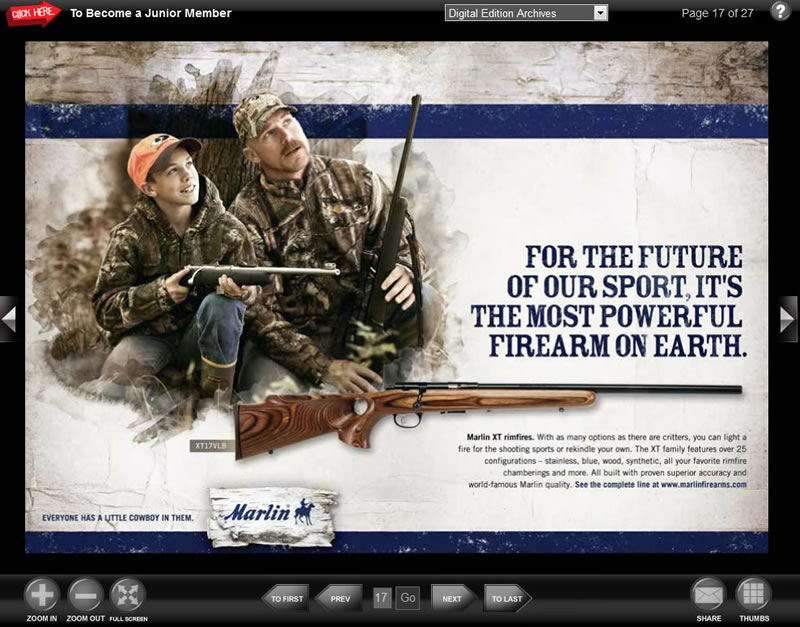

In January 2014, the NRA changed the title of NRA InSights to NRA Family InSights and switched to an online-only format for the magazine with accompanying website. In an editorial announcing the switch, the magazine promised, “In addition to the fun and informative content designed just for Junior members, we’ll be including articles, photos, reviews and news for everyone in your family — parents, grandparents, and other family members.”
In its “Industry Spotlight,” the site features a profile of NRA Board Member Ronnie Barrett, inventor of the 50 caliber sniper rifle. Fifty caliber sniper rifles, used by U.S. troops around the world, can bring down commercial aircraft on takeoff and landing, pierce armor plating, and are accurate to more than a mile. They are banned in the state of California and the District of Columbia, but elsewhere they are as easy to purchase as a hunting rifle under federal law. The promotional profile finishes with, “To read more about Ronnie Barrett and Barrett Firearms, go to www.barrett.net.” By clicking on the link, the reader is taken to Barrett’s website which features solely assault rifles and 50 caliber sniper rifles.68
Under “Kids,” visitors are presented with two subsections: “Under 8” and “8 and Up.” Both include a section titled “Guns.”69
A review of the Thompson/Center HotShot rifle in the “Under 8” section states:
“It’s important to make a distinction here. With the HotShot, we’re not talking about a slightly reduced-size rifle for teens who are not quite ready for a full-size gun. No, we’re talking about a tiny gun intended for the very youngest shooters — the ultimate first gun. ‘We’re targeting the six- to 12-year-old range and feel that with the inclusion of the one-inch spacer in the box, there will be a longer period that the child can use the rifle, potentially out to 15 years old,’ explains…[Craig Cushman, director of marketing for Thompson/Center].”
“That’s important. With the number of hunters declining, it’s crucial to get kids introduced to the sport as early as possible.”
“The HotShot means that even the youngest shooters now have a gun sized just for them.”70
Also included in the website’s “Under 8” section are “Awesome Apps,” which include for $2.99 the NRA Gun Guide app. Text promoting the app asks:
“Do you like the idea of being able to call up the specs of multiple firearms on a whim? Looking to win the next debate about calibers and models at the range? If so the “NRA Gun Guide” app is exactly what you’ve been waiting for.”
“The ‘NRA Gun Guide’ is searchable by gun type, action type, manufacturer, price range and caliber/gauge, making it easy to find out vital info about the rifle in your local gun store or that pistol your buddy is trying to get you to buy at an inflated price.”
“With an easy-to-follow design, the “NRA Gun Guide” is suitable for all levels of interest in firearms or experience with mobile apps. And, as new content is regularly added, it can only get better.”71
When opened, the app promises “Hundreds of Guns Inside!” The “Semi-Auto Handguns ” category of the app contains a wide range of pistols from major manufacturers (Beretta, Colt’s Manufacturing, Glock, Heckler & Koch, Kel-Tec, Sig Sauer, Smith & Wesson, Sturm, Ruger & Company, and others) including numerous high-capacity firearms as well as guns recommended for concealed carry. The “Semi-Auto Rifles” category of the app is dominated by military-style assault rifles — AR-15s and others, including 50 caliber sniper rifles. Assault rifle manufacturers included in the category include Barrett, Beretta, Bushmaster, Colt’s Manufacturing Co., DPMS, FNH-USA, Heckler & Koch, Rock River Arms, and others.
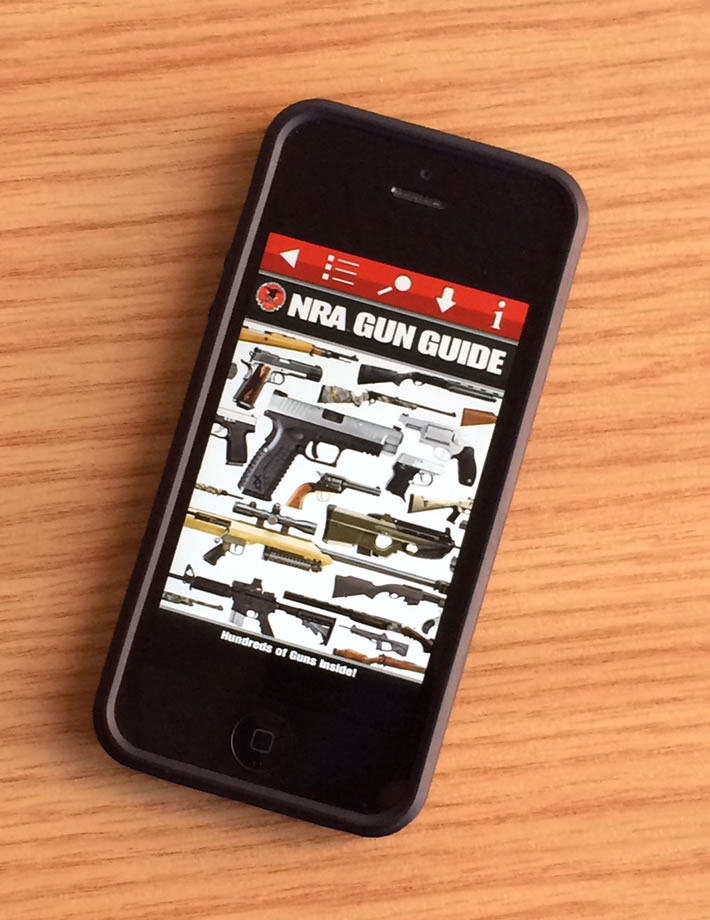
An article titled “My First .22 Pistol” offers reassurance to those wanting to introduce children to guns: “Fortunately for you, there are many people — neighbors, coaches, competitors, sales staff — who want to encourage youth shooters and turn them into lifelong firearms enthusiasts and Second Amendment advocates.” The article notes that a young person’s first pistol may come from brothers or sisters, or a “hand-me-down from someone you meet at the shooting range.”72 73
The NRA has a wide range of additional programs focused on youth, some of which are named for their gun industry funders, such as the Brownells/NRA National Youth Shooting Sports Ambassador Program, Brownells/NRA Day, and the Winchester/NRA Marksmanship Qualification Program. (In addition, the NRA has launched a concerted online effort with gun industry support to reach out to Millennials.)
National Shooting Sports Foundation
While the National Rifle Association functions as the unofficial trade association for the firearms industry, the National Shooting Sports Foundation (NSSF) is its official trade association. In a grim irony, NSSF’s headquarters was once located in Newtown, Connecticut. The role played by the NSSF within the gun industry is not unlike that which was played by The Tobacco Institute for the tobacco industry. The NSSF offers a wide range of publications for its industry patrons, focusing primarily on marketing. At the same time, just as The Tobacco Institute denied a causal link between cigarettes and cancer, the NSSF continually works to minimize the hazards associated with exposure to firearms, especially by children.
For example, in December 2011, NSSF issued a press release that made the claim that hunting, as measured by injuries per number of participants, was actually safer than bowling, claiming a “percentage of injury per 100 participants” of only .05 percent compared to .06 percent for bowlers. Using NSSF’s math, hunting was behind only camping and billiards in its low rate of injury. Other activities NSSF claimed hunting was safer than included golf and tennis. Left out of NSSF’s equations were the severity of injuries for each category, that is, those injuries, if counted, that resulted in crippling disability or death (a distinction that might have benefited golf and tennis as compared to hunting, which included not only those injured by gunfire, but also from falling out of treestands).74 Soon after, in a focus group of 12- to 16-year-olds conducted for NSSF and another organization, a similar argument was made and countered:
“A substantial number of individuals said that hunting and target shooting were rather dangerous activities due to the involvement of firearms. However, others insisted that hunting and shooting were no more dangerous than many mainstream sports; one person suggested that although the rate of injuries in hunting and target shooting is generally lower, any accidents that do occur are more likely to be fatal.”75
In all of NSSF’s publications the lethal risk from guns is rarely acknowledged, except as a marketing hurdle. When it is, gun death is consistently presented as being synonymous solely with unintentional shootings. Rarely are gun homicides — with youth as either perpetrators or victims — or suicides ever mentioned. Moreover, the risk of death from guns is, at best, only hinted at as illustrated by this “Message to Kids About Firearms Responsibility” from NSSF’s A Parent’s Guide to Recreational Shooting for Youngsters—
“Not long ago, in another town, some kids found a firearm. Maybe they were looking for it because of something they saw on television. Maybe one of them dared the other to find it. Maybe they just found a firearm that was left out by mistake. It doesn’t matter why they found it. What matters is the firearm was loaded, and they played with it. Now they are very sorry they did. Don’t let this happen to you.”76
The passage is striking, but not unique, in its ability to place blame, whether it be on television, negligent parents, or the kids themselves, on virtually anyone except the industry.
NSSF issues a constant stream of publications, both to support, and defend, the firearms industry in the marketing of its products. Recent NSSF marketing publications (some publicly available, others limited to NSSF industry members) include titles such as: Millennials and The Shooting Sports: An In-Depth Exploration (2014); Understanding Diversity in Hunting and Shooting Sports (2013); Understanding the Impact of Peer Influence on Youth Participation in Hunting and Target Shooting (2012); and, Understanding Activities that Compete with Hunting and Target Shooting (2012).
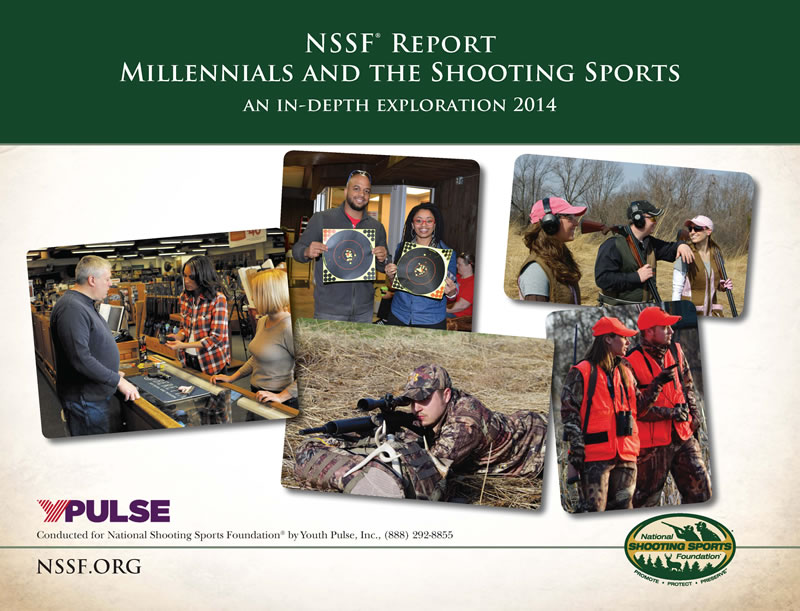
Among the “11 main points to consider” in the executive summary of the NSSF report Understanding Activities that Compete with Hunting and Target Shooting are “Electronic and indoor recreation are a threat to recruiting new hunters and target shooters,” “Losing hunters and target shooters to competing activities is a subtle process,” and, “Start them young.”77
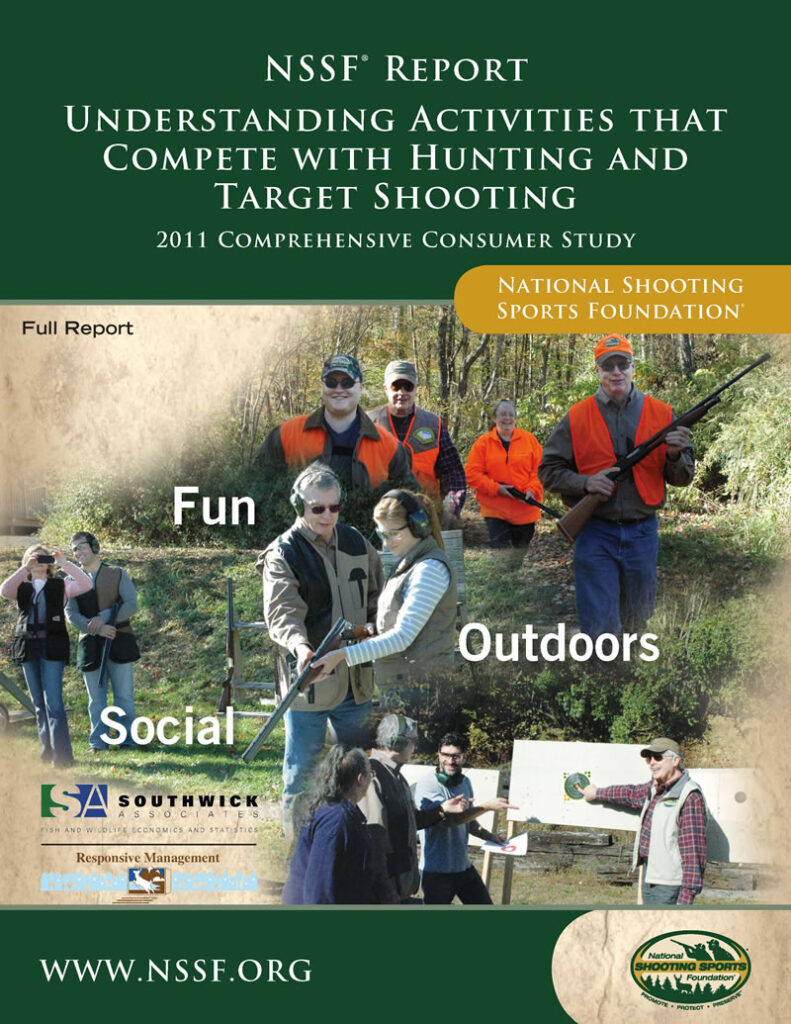
Discussing the “threat” posed by electronic and indoor recreation, the report presents findings “worth noting” from a 2010 study by the Kaiser Family Foundation: “It is estimated that today’s youth 8 to 18 years old spend an average of 53 hours a week on electronic media entertainment,” and, “Nearly three-quarters (71%) of youth have a television in their bedroom.” NSSF suggests, “Rather than trying to stop youth from using electronic media, the hunting and target shooting industry should use those media to its advantage.” “Tactical strategies” toward this end as cited in the report include:
- “The industry should use social media and web sites to raise interest and help youth find ways to hunt and target shoot.”
- “The industry should team with current online media firms to take advantage of their reach and their abilities to communicate with youth.”
- “Because youth are online to be entertained, messages that emphasize fun should be used in this setting.”78
Under a section titled “Start Them Young,” the report states, “There is a clear link between avidity and age of initiation in hunting….”79 “Tactical strategies regarding initiation” detailed in the study include:
- “To help hunting and target shooting get a head start over other activities, stakeholders such as managers and manufacturers should target programs toward youth 12 years old and younger. This is the time that youth are being targeted with competing activities.”
- “It is important to consider more hunting and target shooting recruitment programs aimed at middle school level, or earlier.”
- “Programs that have helped in hunting and target shooting recruitment should be implemented; for instance, it is important to implement more youth programs like Families Afield80 and apprentice licenses.”81
Recognizing that “not all youth can be born into the ideal environment for creating a lifelong hunter or shooter (i.e., as a male within a hunting or shooting family in a rural environment),”82 the 2012 report Understanding the Impact of Peer Influence on Youth Participation in Hunting and Target Shooting urges that a “’Youth Hunter and Shooter Ambassador Program’ be initiated to capitalize on the current population of youth hunters and shooters who can positively influence their fellow peers’ attitudes toward the sports.”83 The report, sponsored by both NSSF and the Hunting Heritage Trust, explains how such “youth ambassadors” would be “performing a major service for the hunting and shooting sport communities”—

“The more familiar youth are with individuals their own age who participate in hunting and shooting, the more likely they will be to support and actively participate in these activities. In this sense, youth hunters and shooters are the key to their fellow friends’ and students’ acceptance of these activities. Given this direct relationship, it is imperative that youth hunters and shooters recognize the weight and importance of their words and actions with regard to their peers’ perceptions of hunting and target shooting…”
“If non-hunting and non-shooting students talk with, befriend, and interact with youth who are actively involved in hunting and shooting, the positive aspects of these activities will increasingly be thought of as acceptable, appealing, and inviting recreational activities.”84
The report also urged the use of social media, noting:
“[T]alk and communication about hunting and shooting should be encouraged and promoted in as many ways as possible, especially through social media. One individual from the [youth] focus groups mentioned photos a hunting classmate had posted on Facebook ─ as with this individual, such photos tend to encourage questions, invite curiosity, increase interest, and place hunting and shooting activities in the foreground of the social atmosphere. Youth, in particular, are uniquely positioned to take advantage of the most prominent and effective means of social media and other communication tools — hunting and shooting sponsoring agencies and organizations should encourage this tendency wherever possible. In promoting the use of images, remember that pictures are often worth a thousand words: images promoting hunting and shooting should reinforce a positive atmosphere that emphasizes the environment, nature, the outdoors, nice weather, exercise, natural resources, wildlife, a social atmosphere among friends and peer groups, etc.”85
The report also urged that “youth ambassadors and others should focus on getting newcomers to take a first step into target shooting through any means, whether a BB or pellet gun, paintball gun, or archery bow. The point should be to get newcomers started shooting something, with the natural next step being a move toward actual firearms. Initial interest, however, should be embraced in whatever form it presents itself.”86
“’Reality’ Video Games”
In the competition for the recreation time of youth, video games are seen by the gun industry as both a threat to, and an opportunity for, marketing firearms to youth.
Bud Pidgeon, president of the U.S. Sportsmen’s Alliance warns, “By the time kids are in fifth grade, or even before, they’re already being pulled away by the allure of video games, organized sports or other activities.”87 And an article detailing NSSF’s 2015 Shooting Sports Summit warned, “What those young people appear to be most interested in, at least superficially, is playing computer games, tapping on tiny keyboards and communicating with their friends through social media like Facebook, Twitter, Instagram and other websites.”88
Yet while video games are seen as a competitor for the leisure time of children, the argument is frequently made, both inside and outside the industry, that first-person shooter games, and their use of easily identified real-world weapons, offer marketing opportunities.
According to Ralph Vaughn, who negotiates licensing deals with video game manufacturers on behalf of Barrett Firearms, manufacturer of 50 caliber anti-armor sniper rifles as well as assault rifles, “It is hard to qualify to what extent rifle sales have increased as a result of being in games…But video games expose our brand to a young audience who are considered possible future owners.”89
In a column on the website Gun Nuts Media, author Caleb Giddings discusses the guns used in the latest edition of the video game series Battlefield. After discussing the video, he concludes:
“There is a real point to all this digital nonsense though, and something that I saved for last. This game and games like it are absolutely how the next generation of gun owners are getting introduced to firearms. The incredible amounts of realism present in the depiction of firearms in game is a good thing. I guarantee that people will come into gun ranges and say ‘I shot something just like that in Battlefield.’ The immediate response of any employee of any range in the nation should be ‘that’s awesome! Want to try the real deal?’”90
Among the concurring statements in the comments section of the article91 were:
- “I agree 100% that games like this can increase the number of ‘gun people.’ In the range I work in, It’s very common to have younger people ask to see then rental guns, and can name many of them off (Beretta 92, AR, Glock, 1911, etc.) based on game experience. Then they get to try one for real and most of them are hooked! I don’t know if it’s what the game designers intended, but it works.”
- “Though gaming may be more realistic when it comes to firearms and operating, like you said, many people are being introduced to firearms through mediums like this. It is always great that video game devs would put a lot of attention to detail when it comes to subjects like this and seeing them play out IRL [In Real Life]…”
- “The last generation of games have a big influence on the purchasing decisions of prospective gun owners of a certain age. I dare say that half of the PS90s sold are probably because of Counter-Strike, and I think it’s responsible for some of the demand for Beretta Elites, as well.”
As accessory manufacturer Firefield sums it up: “A majority of Firefield users grew up watching action-packed movies, TV shows and playing interactive video games that encompass tactical gear and military-style weapons platforms. Our optics and shooting accessories allow shooters to turn what they’ve seen on the screen into a reality.”92
In 2007, Chris Dolnack, National Shooting Sports Foundation senior vice president, used the term “a ‘reality’ video game” to describe the organization’s Scholastic Rifle Program (SRP) begun in 2003, telling Junior Shooters magazine, “We developed an action-packed reactive target format – a ‘reality’ video game – that is sure to be a hit with today’s young shooter.”93 While the Scholastic Rifle Program apparently failed to fill that niche, another industry-promoted shooting event has: 3-Gun competition.
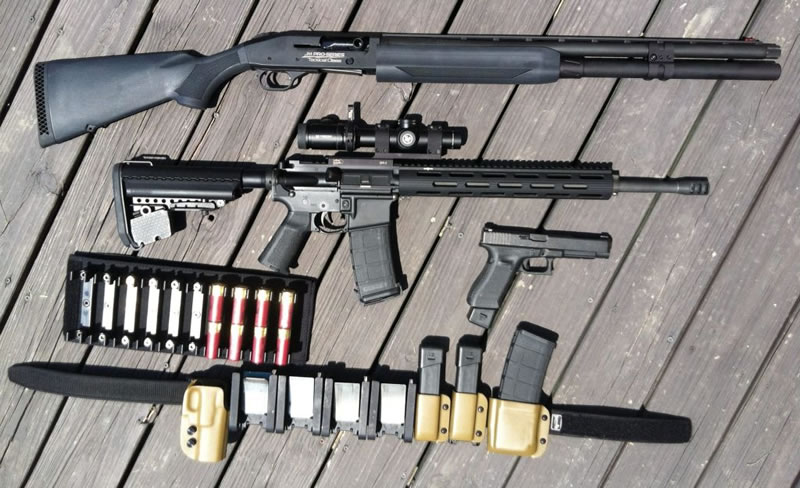
Writing at the website The Truth About Guns, Nick Leghorn promises, “3-gun is as close to a real-life first person shooter video game as you’ll get without joining the military.”94 As described by Leghorn:
“3-gun gets its name from the fact that you use three different types of firearms over the course of the competition: a shotgun, a rifle, and a pistol. You score points by hitting designated targets, which include clay pigeons, cardboard silhouettes, steel targets of varying sizes, and anything else the Range Officer designates as a target….Competitors lose points for hitting “no shoot” targets (hostages, friendlies, etc.) or skipping targets/obstacles. Their score is augmented by the time it takes to complete the course of fire. The person with the combination of fastest time and best accuracy wins.”95
In a video accompanying the article showing a shooter preparing for a 3-Gun match, a participant is asked, “How are you going to game this stage knowing nothing about it?” He replies, “I think it’s kinda like [the video game] Doom, run through, keep upgrading weapons as you kill bad guys, right?”96
Such competitions frequently revolve around fantasy scenarios in which firepower is essential for the hero-shooter to emerge victorious. In its description of its 3-Gun Tactical Match, one gun club explains:
“This type of match has the shooter shooting centerfire rifle, centerfire pistol, and shotgun (.410 or larger) at paper ‘bad guy,’ steel plates, and similar targets. In any given scenario, the shooter moves through an imaginary situation in which his life is placed in danger by the ‘bad guys.’ The scenario will vary from month to month, and will have a theme that practices real-life shooting and defensive skills. Examples of scenarios: exodus from a shopping mall overrun with terrorists, self defense at an ATM machine, Hollywood bank robbery, L.A. riots, home intruder, etc.”97
In the video cited above, the “scenario” is spelled out for the 3-Gun participant as he’s led hooded, his wrists tied together, into a faux prison cell and seated (see video):
Video from The Truth About Guns shows a 3-Gun participant ready to start the competition
“Okay all you troopers are such badasses you decided you were going to go hunt pirates in Somalia…Something went wrong and you are now the prisoner of a Somali warlord who wants to do very bad things to you because you’re an American…No one’s coming to rescue you so you have to rescue yourself…During your last interrogation you noticed that the chair was rough on the sides. That might assist you in breaking your bonds should you be given the opportunity…At that point you should find yourself a gun. Cause we’re Americans and we all like guns. Find one and start killing all the bad guys who are trying to do very bad things to you and your fellow Americans.”98
In the pages of Junior Shooters, 3-Gun competitions are a mainstay, with child participants not only promoting the activity in its pages, but also lauding the gun companies that donate guns, ammunition, and other products: both for use in the activity and as prizes for the winners. As one article written by a 12- and 16-year-old states:
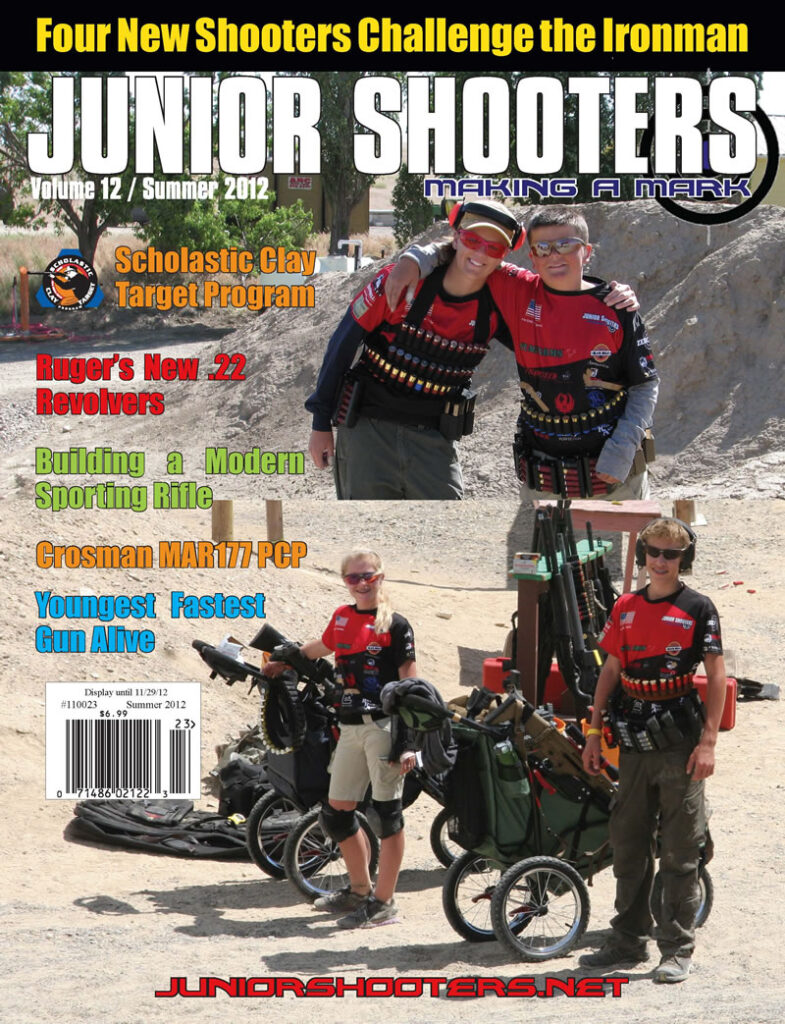
“Everything about 3-Gun is exactly the opposite of precision rifle. Precision to me is boring. All you do is stand there and shoot. With 3-Gun you get to “get into it.” You get to run around (as long as you’re safe), shoot “big boy guns,” and go through obstacles shooting at the targets. Can it get any better? I think not. I felt like an FBI or a SWAT agent going in for a big bust. It was an awesome feeling.”99
Writing in Junior Shooters, Corey Shaw, age 17, exulted:
“This summer I had the opportunity to shoot Fabrique Nationale Herstal (FNH) USA’s SCAR. SCAR is an acronym for Special Combat Assault Rifle. And, oh, boy, is it SPECIAL!”
“Due to the fact that the SCAR is so light, you can fling it around from target to target; sometimes it feels more like you’re shooting a .22 rather than a full-on combat rifle.”100 101
In a Junior Shooters article titled, “Why I Love 3-Gun!,” 12-year-old Jake Denno writes:
“Besides the three guns that have to be practiced with and brought to the match, many of the 3-Gun events will have special or stage weapons, as well…I have already been fortunate enough to be able to shoot a fully automatic UZI, an M-249 SAW and an M-203 grenade launcher. Some of the other special weapons in 3-Gun matches include MG-42 and M-60 machine guns, suppressed ARs and SCARs, but the one I really want to shoot is the Dillon Mini-Gun at the Larue Tactical match. Some events will also have manufacturers there who will have their pistols and shotguns as stage weapons. The only thing I do not like about stage and special weapons is that the score depends on how one shoots with an unfamiliar weapon. The triggers and sights are usually really different from what I shoot, and the guns don’t always run well. At the Ironman [competition], the UZI just would not function properly, and it really threw me off my plan for that stage.”102

Like the gun industry and gun lobby’s ongoing campaign to attempt to rebrand assault rifles as “Modern Sporting Rifles,” by labeling 3-Gun competitions a “sport,” their hope is to not only engage young shooters, but also that the activity offers the necessary cover to maintain the sale and possession of weapons that were originally designed for military or law enforcement use, including assault weapons that should be banned for import under the “sporting purposes” test of the Gun Control Act of 1968.103 As Michael Tenny, CEO of Cheaper Than Dirt!, an online vendor of guns, ammunition, and accessories that describes itself as “America’s Ultimate Shooting Sports Discounter,” told Junior Shooters, “We’re always happy to be able to support the shooting sports in any way possible, and we’re even more excited to help encourage new shooters by sponsoring the 3 Gun Nation Junior division…Faced with political pressure to ban the importation of the competition shotguns that have made 3-Gun into the sport it is today, I think it’s critical that we as an industry pull together to support all of the shooting sports in any way we can.”104
The Facts on Children and Guns
Much like the tobacco industry before it, the firearms industry — gun and accessory manufacturers, trade associations (both self-proclaimed, such as the NSSF, and de facto, such as the National Rifle Association) and related publications — consistently denies the risk associated with its products, especially in the marketing of guns to children. As noted earlier, their arguments, such as NSSF’s assertion that hunting is safer than bowling, can at times be so divorced from reality that they cross the line from the absurd to the surreal.
Despite the rosy picture painted by the firearms industry, the combination of children and firearms poses risks that are widely recognized. These include death and injury, not just from unintentional shootings, virtually the sole category of firearm death acknowledged by the gun industry, but suicide and homicide. In addition, the exposure to lead that young shooters experience — either when firing a weapon or making their own ammunition, a practice commonly known as “hand loading” — can harm many different body organs and systems, including the brain, and exposure can lead to reduced intelligence as well as behavioral problems.
Youth Gun Deaths
In 2023, more than 2,500 children under the age of 18 died from firearms: 1,622 homicides, 746 suicides, 126 unintentional shootings, and 72 deaths from undetermined intent. From 2001 to 2023, nearly 38,000 children under the age of 18 died from guns: 22,532 homicides, 12,098 suicides, 2,366 unintentional shootings, and 770 deaths from undetermined intent.
Firearm Deaths in the United States, Less Than 18 Years of Age, 2001 – 2023105
| Year | Homicide | Suicide | Unintentional | Undetermined Intent | Total |
|---|---|---|---|---|---|
| 2001 | 835 | 451 | 125 | 16 | 1,427 |
| 2002 | 872 | 423 | 115 | 26 | 1,436 |
| 2003 | 805 | 377 | 102 | 25 | 1,309 |
| 2004 | 868 | 384 | 105 | 22 | 1,379 |
| 2005 | 921 | 412 | 127 | 25 | 1,485 |
| 2006 | 1,082 | 371 | 102 | 24 | 1,579 |
| 2007 | 1,038 | 325 | 112 | 36 | 1,511 |
| 2008 | 984 | 361 | 98 | 26 | 1,469 |
| 2009 | 887 | 401 | 83 | 16 | 1,387 |
| 2010 | 835 | 375 | 98 | 26 | 1,334 |
| 2011 | 730 | 448 | 102 | 23 | 1,303 |
| 2012 | 740 | 457 | 78 | 15 | 1,290 |
| 2013 | 640 | 491 | 94 | 23 | 1,248 |
| 2014 | 703 | 532 | 69 | 19 | 1,323 |
| 2015 | 785 | 566 | 77 | 24 | 1,452 |
| 2016 | 862 | 633 | 104 | 31 | 1,630 |
| 2017 | 919 | 729 | 95 | 51 | 1,794 |
| 2018 | 864 | 725 | 88 | 45 | 1,722 |
| 2019 | 938 | 657 | 88 | 41 | 1,724 |
| 2020 | 1,376 | 721 | 121 | 58 | 2,276 |
| 2021 | 1,552 | 827 | 140 | 65 | 2,584 |
| 2022 | 1,674 | 686 | 117 | 61 | 2,538 |
| 2023 | 1,622 | 746 | 126 | 72 | 2,566 |
| Total | 22,532 | 12,098 | 2,366 | 770 | 37,766 |
The percentage of homicides committed with guns in this age group has increased drastically over the last two decades, from 46.2 percent in 2001 to 70.8 percent in 2023.
Percentage of homicide victims less than 18 years of age killed with a gun, 2001 – 2023106
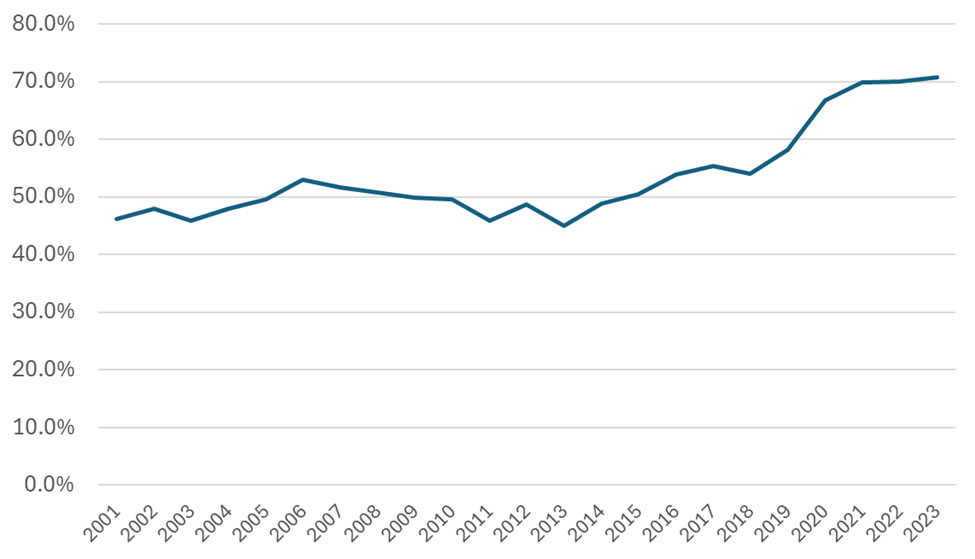
For the age group one year old to 17 years old, unintentional injury was leading cause of death every year between 2001 and 2023. The most common cause of unintentional death among this age group in 2023 was motor vehicle-related deaths (45.5 percent), followed by drownings (16.2 percent). Firearms accounted for 2.5 percent of all fatal unintentional injuries that year.
Homicide increased from the fourth leading cause of death in 2013 to the second leading cause of death in 2020 and has remained the second leading cause of death among children ages 1 to 17 in the United States since then. In 2023, firearms were used in 70.8 percent of all homicides in this age group. Suicide increased from the fifth leading cause of death in 2001 to the second leading cause of death in 2017 through 2019, before dropping down to the third leading cause of death in 2020. Firearms were the most common method used, with nearly half of all suicides among this age group in 2023 occurring by firearm (46.5 percent).
Leading causes of death among children and youth, ages 1-17 years old, 2001 – 2023107
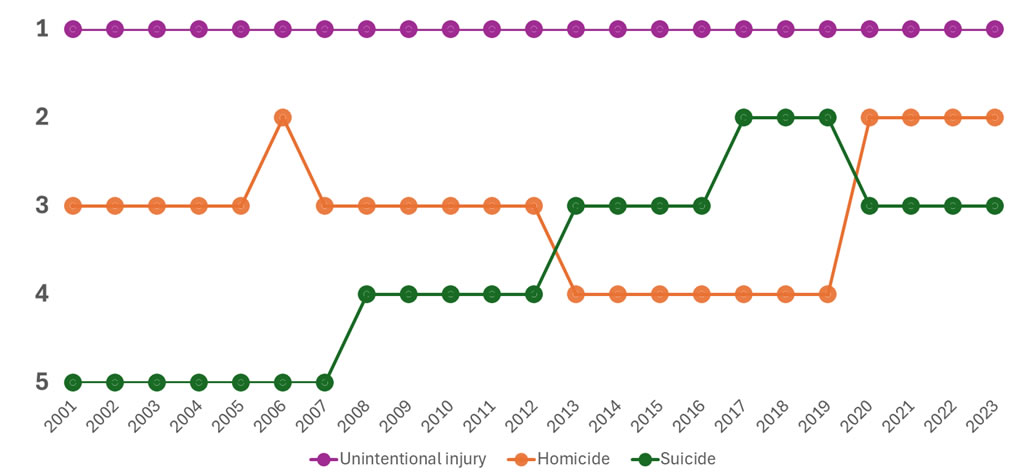
A common myth is that children and teens living in rural areas do not suffer the effects of gun violence experienced by their contemporaries who live in urban environments, despite being exposed to guns at a young age. The fact is that guns kill rural youth at a rate equal to urban youth but in different circumstances. While more urban youth die from gun homicide, the difference is made up in rural areas through firearm suicide and unintentional deaths. A 2010 study in the American Journal of Pediatrics examined all pediatric firearm deaths up to age 19 from 1999 through 2006. The deaths were analyzed by rural-urban settings based on population size and proximity to metropolitan areas. The study concluded:
“Children in the most-rural US counties had firearm mortality rates that were statistically indistinguishable from those for children in the most-urban counties. This finding reflects a greater homicide rate in urban counties counterbalanced by greater suicide and unintentional firearm death rates in rural counties.”108
Parents also have significant ability to prevent youth suicide recognizing that adolescents who commit suicide most often use the family gun.109 By removing guns from homes where children and teens live, especially depressed adolescents, parents will reduce likelihood of suicide and unintentional death for everyone in the household, but especially for teens.
While 85 percent of suicide attempts with guns are fatal, other means are less lethal: only one percent of cutting or piercing attempts are fatal, while only two percent of poisoning/overdose attempts result in death.110 Moreover, studies show that many teen suicide attempts are impulsive. Of teens who survived a suicide attempt, one quarter said they thought of suicide just five minutes before making the attempt. There is also little truth to the widely held belief that those who attempt to kill themselves are determined to succeed. In fact, 90 percent of near-lethal suicide attempts do not attempt to kill themselves again.111
Lead: The Silent Health Threat from Firearms
While the health and safety threats of gun violence can be measured in death and injury, there is another reason guns pose a grave threat to human health and particularly children’s health: the toxic lead found in ammunition.
Lead is a highly toxic metal that is especially harmful to the developing brains of young children. It can harm many different body organs and systems, and exposure can lead to reduced intelligence and many behavioral problems. The federal Centers for Disease Control and Prevention (CDC) maintains there is no safe level of lead in the blood for children, and states, “Even low levels of lead in blood have been show to affect IQ, ability to pay attention, and academic achievement.”112 113
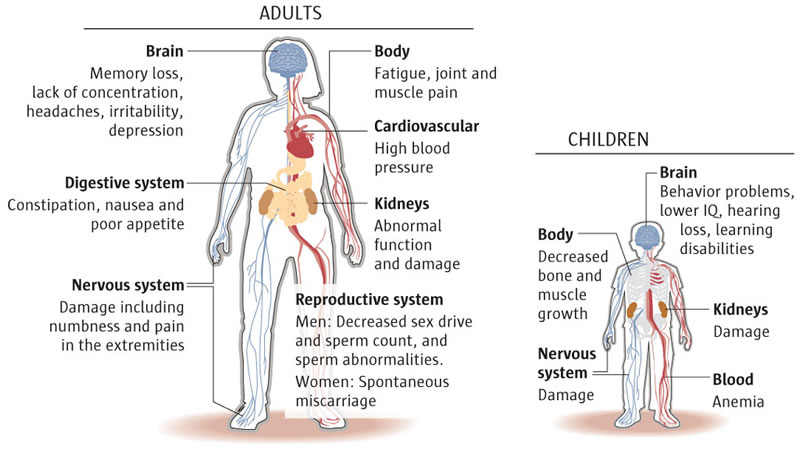
In recent decades, public health-based regulations have dramatically reduced the presence of lead in what were once common sources of exposure for children, such as lead-based paint and lead in gasoline. The major health threat that remains is lead from bullets. The Environmental Protection Agency (EPA) regulates lead in paint and gasoline but is prohibited from regulating the lead contained in cartridges and shells. The EPA has rejected a petition filed by 101 environmental organizations to regulate lead from spent bullets and shot citing a section of the Toxic Substances and Control Act (TSCA) that exempts cartridges and shells from the agency’s reach. Both the NRA and the NSSF intervened in court to object to EPA regulation of lead in ammunition.114 A 2013 consensus statement from scientists from across the nation warned: “Lead-based ammunition is likely the greatest, largely unregulated source of lead knowingly discharged into the environment in the United States.”115
For both children and adults, the primary risk of exposure comes from shooting ranges, most notably indoor ranges. At the firing range, children can be exposed to lead through particles suspended in the air or even by eating contaminated food. Even when children do not go to the firing range themselves, they can be contaminated by clothing or accessories from adults returning from the range.116 The CDC recommends that individuals “shower and change clothes after finishing a task that involves working with lead-based products, such as stained glass, making bullets, or using a firing range.”117
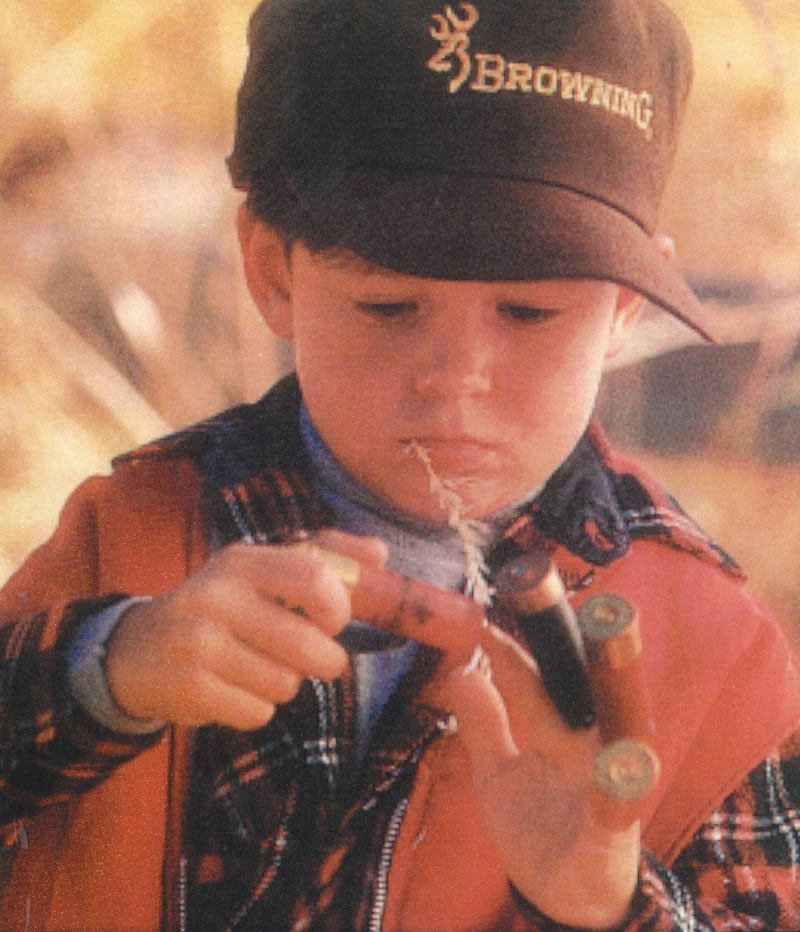
Yet despite the well-documented public health risk, shooting ranges remain a largely unregulated industry. A recent investigation in the Seattle Times revealed that shooting range owners routinely violate workplace safety laws, resulting in their employees as well as their children and adult customers being exposed to lead. The newspaper found that only 201 of the estimated 6,000 commercial gun ranges in the United States have been inspected within the past decade, but 86 percent of those which had been inspected violated at least one lead-related standard. Thousands more gun ranges are volunteer-led or members-only clubs with no employees, and these do not have to follow federal regulations at all.118 Not surprisingly, while the NRA and its self-described gun industry “corporate partners” will at times pay lip service to the safety hazards posed by lead, their overriding focus remains actively encouraging children to visit shooting ranges. As a medical officer for the National Institute for Occupational Safety and Health told the Seattle Times, “Some firing ranges cater to children, they have birthday parties and special events.” An NRA official, Susan Recce, told the newspaper, “The issue of lead problems for indoor ranges is extremely rare.”119
The facts state otherwise. At a Vancouver, Washington shooting range, tests in 2010 found 20 youth and young adults on the Rifle and Pistol Club team had been overexposed to lead. “We weren’t very cautious,” one of the participants was quoted as saying. “We would get lead on our hands and eat finger food.” Tests showed that the floor of the range had a lead level 993 times that allowed by a federal housing guideline.120
There is no cure or treatment for the effects of lead exposure, and the effects are chronic and irreversible. The only option is prevention. And yet, the response from all too many parents is to ignore the threat. In response to an online discussion thread titled “is 3 yrs old too young to help dad clean ar [AR-15 assault rifle]?,” one commenter responded:
“The whole lead, chemical paranoia is out of control IMO [in my opinion]. I grew up with lead paint, played with lead toy soldiers, dunked my hands in kerosene while cleaning car parts and used real MEK to degrease stuff. According to my doc I’m in good health aside from high cholesterol. Use common sense. Don’t let your kid drink Hoppe’s or Frog Lube. Don’t let him stick his hands in his mouth…He’s more likely to drown or get hurt at the playground than die for touching the bolt of a rifle once a week.”121
Conclusion and Recommendations
The efforts of the gun industry and gun lobby to put firearms in the hands of young children and teens are the exact opposite of what health experts advise. The American Academy of Pediatrics is emphatic in urging parents not to keep guns in homes with children. Their healthychildren.org website advises parents, “The best way to keep your children safe from injury or death from guns is to NEVER have a gun in the home.” Specifically, the pediatricians’ organization warns parents as follows:122
- Do not purchase a gun, especially a handgun.
- Remove all guns present in the home.
- Remember that young children simply do not understand how dangerous guns can be, despite parents’ warnings.
- Find out if there are guns in the homes where your children play. If so, talk to the adults in the house about the dangers of guns to their families.
“For those who know of the dangers of guns but still keep a gun in the home,” the site advises:
- Always keep the gun unloaded and locked up.
- Lock and store the bullets in a separate place.
- Make sure to hide the keys to the locked boxes.
As noted, one study found that adolescents who commit suicide most often use the family gun.123 By removing guns from homes where children and teens live, especially depressed adolescents, parents will reduce likelihood of suicide and unintentional death for everyone in the household, but especially for teens.
A common argument is that giving children guns teaches them personal responsibility and other life skills. Typical is the language found on the website of National 4-H Shooting Sports, which promises “Skills for Life — Activity for a Lifetime.” Sponsors of the program include: the National Shooting Sports Foundation; online accessories and ammo vendor MidwayUSA (headed by top NRA donor Larry Potterfield); the ammunition manufacturer Hornady (headed by NRA board member Steve Hornady); and, Hodgdon Powder (headed by one-time NRA board member Bob Hodgdon). In the “Just for Youth” section under the heading “Kids ‘n’ Guns,” the site states:
“4-H uses shooting sports to teach youth development. Our programs are valuable for helping young people develop self-confidence, personal discipline, responsibility, teamwork, self esteem and sportsmanship. The discipline and self-control required for responsible firearms use carries over into many other aspects of life.”124
In the same section, the question is asked, “Isn’t easy access to firearms one reason for the violent behavior we’ve seen in Columbine and other school shootings?” The response is as predictable as it is disingenuous: “No, access is not the issue. The safest location for a responsible gun owner to store a firearm is the secure environment of his or her home…Firearms should however, be stored so that they are inaccessible to unauthorized users.”
Left unstated is the fact that with the creation of the youth gun culture envisioned by the firearms industry and the gun lobby, the children themselves in the home are all too often the authorized users.
At the same time, the “skills” learned by youth at the foot of today’s gun industry — with its embrace of heightened lethality and increased militarization, combined with the immaturity and limited judgment that define childhood — can be put into action with horrific results.
In addition to urging that homes with children be gun-free, the Violence Policy Center recommends the following:
- Firearms are an adult product just like tobacco and alcohol and should be treated as such to protect the health and safety of children. Just as our society does not condone the use of alcohol or tobacco by minors even with adult supervision, we should prohibit the acquisition, possession, and use of firearms by children. Current federal law prohibits the transfer of handguns by Federal Firearms License (FFL) holders to anyone under the age of 21. Federal law also prohibits handgun possession by those under the age of 18 with a number of exceptions. Federally licensed dealers are also prohibited from selling long guns (shotguns and rifles) to those under the age of 18. These laws should be revised so that possession standards strictly match sales standards: 18 years old for long guns and 21 years old for handguns.
- The Federal Trade Commission should investigate whether the firearms industry is inappropriately marketing firearms to children and also whether manufacturers are engaged in product placement of firearms in video games marketed to minors to determine whether such efforts violate applicable advertising standards.
- Websites for gun manufacturers and vendors of related products (such as ammunition and ammunition magazines) should have the same age restrictions and criteria for access as those for tobacco and alcohol vendors.
- Congress should repeal the section of the Toxic Substances Control Act prohibiting the Environmental Protection Agency from regulating lead in ammunition.
- States should review their laws regarding firearm possession by children with the goal of having the age for legal possession at least match that for legal purchase from a Federal Firearms License holder.
- An effective public education campaign should be developed and implemented to warn parents and youth about the dangers associated with the presence and use of firearms.
To put the gun industry and gun lobby’s child-marketing efforts into perspective, imagine the public outcry if the alcohol industry announced a program targeting grade school children, promoting a line of “youth cocktails.” Or if the tobacco industry urged parents to introduce their second and third grade-age children to the satisfaction and sophistication of smoking with “junior cigarettes.” Or if it was revealed that these industries had a “strategic plan” targeting children to not only “start them young,” but to create a cadre of “youth ambassadors,” whose goal would be to convince their playmates via personal contact and social media to join them in these adult activities. Yet, the firearms industry and gun lobby are today aggressively pursuing just such a campaign targeting America’s youth.
And while the firearms industry and gun lobby consistently work to present this marketing effort in terms of tradition and family, the real impetus lies in profit and political power. Most tragically, the effects of this campaign are all too often measured in unnecessary death and crippling injury.
Copyright © February 2016 Violence Policy Center
The Violence Policy Center (VPC) is a national nonprofit educational organization that conducts research and public education on violence in America and provides information and analysis to policymakers, journalists, advocates, and the general public.
This publication was funded with the support of the Lisa & Douglas Goldman Fund.
Primary author for this study was Josh Sugarmann. Additional research and writing was provided by Marty Langley, Avery Palmer, Kristen Rand, and Jane Wiesenberg.
The VPC would like to express its sincere appreciation to Sue Roman for the photographs and companion video she contributed to the study. (See https://youtu.be/rjKXGN7hYcg for video).
For a complete list of VPC publications with document links, please visit http://vpc.org/publications/.
To help support the work of the Violence Policy Center by making a tax-deductible contribution, please visit www.vpc.org/contribute.htm.
The Title – “Start Them Young” is a section head of the 2012 National Shooting Sports Foundation (NSSF) publication Understanding Activities that Compete with Hunting and Target Shooting, 2011 Comprehensive Consumer Study, Executive Summary. NSSF is the official trade association for the firearms industry.
The Photo – “A chilling photograph of a small boy, gnawing on a pistol clutched in his tiny hands, dressed in camouflage and with a grenade and ammunition belt in his lap, was recovered from the weapon-filled home of Sandy Hook school gunman Adam Lanza….A family friend said that Lanza and his older brother were taught to shoot almost as soon as they could hold a weapon by their mother Nancy, a gun fanatic. But a spokesman for Mrs. Lanza’s ex-husband, Peter, last night denied that the child in the uncaptioned photograph was either son.” – “Sandy Hook report reveals Lanza children’s early exposure to guns,” The Telegraph, December 28, 2013
- “Father of Marysville school shooter convicted of gun charges,” Seattle Times, September 29, 2015; “’Bang, Bang I’m Dead’: Marysville Shooter Jaylen Fryberg’s Ominous Texts – NBC News,” nbcnews.com, November 20, 2014; “Death Toll Rises to 5 in School Shooting,” Associated Press, November 8, 2014; “Second Washington school shooting victim dies after homecoming prince took aim at his friends, family,” Washington Post, October 27, 2014; “Marysville school shooting: What more could the community have done?,” Christian Science Monitor, October 26, 2014; “Tangled Portrait of a Student Emerges in Washington Shooting,” New York Times, October 25, 2014.
- “Troutdale police release parts of interviews with father, brother of Reynolds High shooter,” OregonLive, April 6, 2015 (http://www.oregonlive.com/portland/index.ssf/2015/04/troutdale_police_release_31_pa.html); “NRA mouthpiece Wayne LaPierre quiet as Oregon high school shooter revealed to conceal AR-15 rifle in guitar case,” Daily News, June 12, 2014 (http://www.nydailynews.com/news/national/school-shooter-portland-ore-ar-15-report-article-1.1825533); “Reynolds High School shooter Jared Padgett died of self-inflicted wound,” koin.com, June 11, 2014 (http://koin.com/2014/06/11/reynolds-high-school-news-briefing-june-11-2014/); “Reynolds High shooter Jared Padgett ‘showed off about guns,’” koin.com, June 11, 2014 (http://koin.com/2014/06/11/reynolds-high-shooter-jared-padgett-showed-off-about-guns/); “Oregon school shooting: Gunman Jared Michael Padgett known as serious student with interest in military,” The Oregonian, June 11, 2014 (http://www.oregonlive.com/gresham/index.ssf/2014/06/oregon_school_shooting_gunman.html); “Jared Michael Padgett: Troutdale Shooting Suspect Argued With Classmates About Hitler,” Inquisitr, June 11, 2014 (http://www.inquisitr.com/1294499/jared-michael-padgett-troutdale-shooting-suspect-argued-with-classmates-about-hitler/); “Jared Padgett Photos: Reynolds High School Gunman Jared Michael Padgett Facebook Pictures Out,“ Epoch Times, June 11, 2014 (http://www.theepochtimes.com/n3/728899-jared-padgett-photos-reynolds-high-school-gunman-jared-michael-padgett-facebook-pictures/).
- “Waseca teen accused in school shooting plot had been planning for months,” Star Tribune, December 17, 2014 (http://www.startribune.com/local/257505631.html#qRWhjsAGA7Oj9pMX.97); “Recording released of Minnesota teen calmly telling police of plans to kill family and set off school massacre,” Daily Mail, June 25, 2014 (http://www.dailymail.co.uk/news/article-2668478/Recording-released-Minnesota-teen-calmly-telling-police-plans-kill-family-set-school-massacre.html); “Teen details massacre plot, reveres Columbine killer,” USA Today, June 25, 2014 (http://www.usatoday.com/story/news/nation/2014/06/25/teen-plot-bomb/11349075/); “Recording released of Minnesota teen calmly telling police of plans to kill family and set off school massacre,” Daily Mail, June 25, 2014 (http://www.dailymail.co.uk/news/article-2668478/Recording-released-Minnesota-teen-calmly-telling-police-plans-kill-family-set-school-massacre.html); “UPDATED: Waseca teen pleads not guilty in mass shooting plot,” Waseca County News, May 12, 2014 (http://www.southernminn.com/waseca_county_news/news/article_e3226229-92a4-5cec-8084-e1f88c297f11.html); “Police: Minnesota teen planned school massacre,” CNN, May 2, 2014 (http://www.cnn.com/2014/05/01/justice/minnesota-attack-thwarted/).
- See, for example, the 2013 Violence Policy Center study Blood Money II: How Gun Industry Dollars Fund the NRA (http://vpc.org/studies/bloodmoney2.pdf).
- NSSF SHOT Business, September/October 1993.
- Shooting Sports Retailer, September/October 1998.
- “Shooting for a New Audience,” Shooting Sports Retailer, May/June 2007.
- General Social Survey (GSS) gun ownership data contained in this report is drawn from the NORC publication General Social Survey Final Report: Trends in Gun Ownership in the United States, 1972-2014, Tom W. Smith, Jaesok Son, NORC at the University of Chicago, March 2015. For a detailed history of gun ownership in the United States as reported by the GSS, see the May 2015 Violence Policy Center report A Shrinking Minority: The Continuing Decline of Gun Ownership in America (http://vpc.org/studies/ownership.pdf).
- Respondents were asked, “Do you (or does your [husband/wife]) go hunting?”
- NSSF Report: Incidence Rate of Hunting With Modern Sporting Rifles, National Shooting Sports Foundation, 2015.
- See http://www.chipmunkrifles.com/chipmunk_aboutus.php.
- See http://www.crickett.com/.
- Ironically, while the company’s Beanie Baby must meet at least four types of federal safety standards – sharp edges and points, small parts, hazardous materials, and flammability – there are no federal safety standards for the domestic manufacture of firearms. For more information, see http://vpc.org/regulating-the-gun-industry/regulate-firearms-like-other-consumer-products/.
- “Watch an Ad for ‘My First Rifle,’ the Gun a 5-Year-Old Used to Shoot His 2-Year-Old Sister,” Slate, May 3, 2013 (http://www.slate.com/blogs/crime/2013/05/03/crickett_keystone_sporting_arms_watch_an_ad_for_my_first_rifle_the_gun_a.html).
- See http://www.littlesportsman.com/.
- “Marlin’s New Kid-Friendly Rifles,” NRA Family InSights, January 2, 2014 (http://www.nrafamilyinsights.org/articles/marlins-new-kid-friendly-rifles).
- “Children and Guns – An Iowa Fail,” Jews for the Preservation of Firearms Ownership, April 21, 2014 (http://jpfo.org/alerts2014/alert20140421.htm).
- “’We wish you peace’: Children of weapons instructor killed in gun range accident make emotional video pledging forgiveness to nine-year-old girl who shot their father,” Daily Mail, September 12, 2014 (http://www.dailymail.co.uk/news/article-2754358/We-wish-peace-Children-weapons-instructor-killed-gun-range-accident-make-emotional-video-pledging-forgiveness-nine-year-old-girl-shot-father.html#ixzz3U1IYxDJD).
- “Choosing Your Child’s First Gun,” American Hunter, November 16, 2012.
- “Choosing Your Child’s First Gun,” American Hunter, November 16, 2012.
- As a 2010 article in the NRA’s American Rifleman magazine noted: “The term ‘tactical .22 rifle’ is essentially an oxymoron. It’s unlikely that a single military or police force on Earth uses .22 Long Rifle arms for small-scale combat operations, at least as primary guns. Nevertheless, this burgeoning class of firearms has taken hold in recent years in the civilian market. With origins dating back to the ever-modular Ruger 10/22, perhaps the most accessorized gun on the planet, up through today’s AR-15 look-alikes, these guns have found a welcome place in the cabinets of varmint shooters, beginning marksmen, and of course those who like to shoot all day with inexpensive, readily available ammunition.” “Tactical 22s: A New Class of Rifles,” American Rifleman, November 19, 2010 (http://www.americanrifleman.org/articles/2010/11/19/tactical-22s-a-new-class-of-rifles/).
- “Why AR-Styled Rifles Are so Popular,” Shooting Sports Retailer, January 2014.
- See http://www.gandermountain.com/modperl/product/details.cgi?i=781756, downloaded September 22, 2015.
- Sig Sauer advertisement, Junior Shooters, Summer 2011.
- “Rifles for Ruger Rimfire,” Junior Shooters, March 2011 Special Edition.
- See https://www.billsgs.com/the-average-joe-archive/214-december-gotm-beretta-arx-160.
- “The Best Guns for Smaller Shooters,” Shooting Sports Retailer, April 30, 2015 (http://www.shootingsportsretailer.com/2015/04/30/best-guns-smaller-shooters/).
- “The Best Guns for Smaller Shooters,” Shooting Sports Retailer, April 30, 2015 (http://www.shootingsportsretailer.com/2015/04/30/best-guns-smaller-shooters/).
- “Henry Repeating Arms: Muddy Girl,” NRA Family, February 21, 2014 (http://www.nrafamily.org/articles/2014/2/21/henry-repeating-arms-muddy-girl/).
- “CZ 452 Scout Rifle,” Junior Shooters, Summer 2011.
- See http://www.smith-wesson.com/webapp/wcs/stores/servlet/Category4_750001_750051_757786_-_757784_757784_image.
- In May 2015, Black Forge Weapons was acquired by Invincible Arms of Ohio, see http://invinciblearms.com/news-and-announcements/invincible-arms-acquires-black-forge-weapons/.
- “The Best Guns for Smaller Shooters,” Shooting Sports Retailer, April 30, 2015 (http://www.shootingsportsretailer.com/2015/04/30/best-guns-smaller-shooters/).
- “Letter from the Editor,” America’s 1st Freedom, December 2004.
- “A Word from Your Editor,” Junior Shooters, Spring 2012.
- “A Word from Your Editor,” Junior Shooters, Spring 2012.
- “A Word from Your Editor,” Junior Shooters, Winter 2012.
- Junior Shooters, March 2011 Special Edition.
- “Is the Shooting Industry Getting it All Wrong?,” Shooting Sports Retailer, July 31, 2015 (http://www.shootingsportsretailer.com/2015/07/31/shooting-industry-getting-wrong/).
- See http://www.juniorshooters.net/aboutus/.
- See http://www.juniorshooters.net, downloaded November 13, 2015.
- See http://www.juniorshooters.net/aboutus/.
- “A Word from Your Editor,” Junior Shooters, Spring 2012.
- Founded in 1996, “The International Defensive Pistol Association (IDPA) is the governing body of a shooting sport that simulates self-defense scenarios and real life encounters…One of the unique facets of this sport is that it is geared toward the new or average shooter, yet is fun, challenging and rewarding for the experienced shooter. The founders developed the sport so that practical gear and practical guns may be used competitively.” On its website, IDPA poses the question, “WHY ANOTHER SHOOTING SPORT?,” and answers: “Prior to the formation of IDPA, there was no place to compete and hone one’s skill with equipment designed for & suitable for self-defense (http://www.idpa.com).
- “A Word from Your Editor,” Junior Shooters, Spring 2012.
- “Why I Love Bushmaster AR-15s…You Should, Too,” Junior Shooters, Summer 2012.
- “45 Firearms Developed Specifically for Smaller-Statured or Younger Shooters,” Mossberg press release, June 30, 2014 (http://www.juniorshooters.net/2014/07/06/mossbergs-youth-firearms-and-safety/).
- “Adams Arms 14.5-inch Evo Ultralite Piston MSR Upper,” Junior Shooters, Summer 2013.
- “Adams Arms 14.5-inch Evo Ultralite Piston MSR Upper,” Junior Shooters, Summer 2013.
- “The Mosquito: A Cool .22 With A Sting,” Junior Shooters, Summer 2009.
- “Sig Sauer’s Mosquito,” Junior Shooters, Summer 2013.
- “Sig Sauer’s Mosquito,” Junior Shooters, Summer 2013.
- “Sig Sauer’s Mosquito,” Junior Shooters, Summer 2013.
- “Sig Sauer’s Mosquito,” Junior Shooters, Summer 2013.
- “Glocks are for Girls,” Junior Shooters, Summer 2009.
- “Kids Gear!,” Junior Shooters, Summer 2010.
- Junior Shooters, Winter 2011.
- Junior Shooters, March 2011.
- Junior Shooters, Winter 2011.
- Junior Shooters, Spring 2013.
- Junior Shooters, Spring 2013.
- Junior Shooters, Winter 2011.
- Junior Shooters, Spring 2013.
- Junior Shooters, Spring 2013.
- “NRA’s Magazine for Juniors Goes Digital,” AccurateShooter.com, September 28th, 2011 (http://bulletin.accurateshooter.com/2011/09/nras-magazine-for-juniors-goes-digital/).
- See https://membership.nrahq.org/forms/signup.asp.
- As of September 23, 2015.
- “Ronnie Barrett: High-Caliber Innovator,” December 19, 2013 (http://www.nrafamily.org/articles/2013/12/19/ronnie-barrett-high-caliber-innovator/).
- See https://web.archive.org/web/20150221040356/http://www.nrafamilyinsights.org/Kids under “Kids.”
- “Test Fire: Thompson/Center HotShot,” NRA Family, January 2, 2014 (http://www.nrafamily.org/articles/2014/1/2/test-fire-thompsoncenter-hotshot/).
- Downloaded from http://www.nrafamilyinsights.org/Kids-Under-8-Awesome-Apps on November 13, 2014 and from https://web.archive.org/web/20141129150952/ http://www.nrafamilyinsights.org/articles/nra-gun-guide-app on September 23, 2015.
- “My First .22 Pistol,” NRA Family, August 8, 2014 (http://www.nrafamily.org/articles/2014/8/8/my-first-22-pistol/).
- On July 20, 2015, the online publication and website NRA Family InSights became the NRA Family website, “designed to cater to the unique needs of American families that own guns, with realistic how-to advice on topics such as safe firearm storage, introducing new shooters and hunters to the sports, outdoor family destinations and entertainment, personal protection tips, historical firearms and figures, gun and gear reviews, news for NRA families, Olympic shooting sports and more.” According to Executive Director of NRA publications Doug Hamlin, “NRA Family was created to serve the millions of NRA families in America. Rather than addressing a specific sport or interest, we’re adopting a holistic approach that includes the needs of mothers, fathers, kids and grandparents who are both eager to learn, and to pass their knowledge on to the next generation.” “NRA Family’s Brand-New Website,” July 20, 2015 (http://www.nrafamily.org/articles/2015/7/20/nra-familys-brand-new-website/).
- “Hunting is Safer Than Golf and Most Other Activities (Not to Mention Football, Basketball and Soccer),” National Shooting Sports Foundation press release, December 5, 2011 (http://www.nssf.org/newsroom/releases/2011/120511.cfm?print=X).
- Understanding the Impact of Peer Influence on Youth Participation in Hunting and Target Shooting: Executive Summary, Hunting Heritage Trust and National Shooting Sports Foundation, 2012.
- “A Parent’s Guide to Recreational Shooting for Youngsters,” National Shooting Sports Foundation, 2014. Also included in the document is a pledge for children to sign which includes the promise that “I will not go snooping or allow my friends to go snooping for guns in the house.”
- Understanding Activities that Compete with Hunting and Target Shooting, 2011 Comprehensive Consumer Study, Executive Summary, National Shooting Sports Foundation, 2012.
- Understanding Activities that Compete with Hunting and Target Shooting, 2011 Comprehensive Consumer Study, Executive Summary, National Shooting Sports Foundation, 2012.
- Understanding Activities that Compete with Hunting and Target Shooting, 2011 Comprehensive Consumer Study, Executive Summary, National Shooting Sports Foundation, 2012.
- Labeled “An Initiative for the Future of Hunting,” Families Afield (http://www.familiesafield.org/), founded by NSSF, National Wild Turkey Federation, and the U.S. Sportsmen’s Alliance, “is an education and outreach program to help states create hunting opportunities for youths, so that more families may enjoy America’s greatest outdoor tradition together.” The National Rifle Association and the Congressional Sportsmen’s Foundation are also “coalition partners” in the program. According to NSSF, “Since its inception, 35 states have passed new laws aimed at removing barriers and making it easier for new people to get into the field and try hunting” (http://www.nssf.org/hunting/youth/). The bulk of the program’s efforts have focused on reducing minimum age requirements for hunting by children and eliminating the need for more rigorous licensing and training for novice hunters. On the program’s website under “Get Involved,” NSSF warns “Hunter Numbers are Declining,” stating, “For every 100 adult hunters today, only 69 youth hunters are coming up to take their place,” while under the heading “Focus on Youth,” the organization stresses that “Youngsters are Key.”
- Understanding Activities that Compete with Hunting and Target Shooting, 2011 Comprehensive Consumer Study, Executive Summary, National Shooting Sports Foundation, 2012.
- Understanding the Impact of Peer Influence on Youth Participation in Hunting and Target Shooting, Executive Summary, Hunting Heritage Trust and National Shooting Sports Foundation, 2012.
- Understanding the Impact of Peer Influence on Youth Participation in Hunting and Target Shooting, Executive Summary, Hunting Heritage Trust and National Shooting Sports Foundation, 2012.
- Understanding the Impact of Peer Influence on Youth Participation in Hunting and Target Shooting, Executive Summary, Hunting Heritage Trust and National Shooting Sports Foundation, 2012.
- Understanding the Impact of Peer Influence on Youth Participation in Hunting and Target Shooting, Executive Summary, Hunting Heritage Trust and National Shooting Sports Foundation, 2012.
- Understanding the Impact of Peer Influence on Youth Participation in Hunting and Target Shooting, Executive Summary, Hunting Heritage Trust and National Shooting Sports Foundation, 2012.
- “The Gun Industry’s Deadly Addiction,” Rolling Stone, February 28, 2013 (http://www.rollingstone.com/politics/news/the-gun-industrys-deadly-addiction-20130228#ixzz3bShTEHM4).
- “Is the Shooting Industry Getting it All Wrong,” Shooting Sports Retailer, July 31, 2015 (http://www.shootingsportsretailer.com/2015/07/31/shooting-industry-getting-wrong/).
- “Shooters: How Video Games Fund Arms Manufacturers,” Eurogamer.net, January 31, 2013 (http://www.eurogamer.net/articles/2013-02-01-shooters-how-video-games-fund-arms-manufacturers).
- “The gun gamer’s dilemma,” Gun Nuts Media, March 25, 2015 (http://www.gunnuts.net/2015/03/25/the-gun-gamers-dilemma/).
- All typos or grammatical errors in original text.
- Perhaps recognizing the risks that come with turning what shooters have “seen on the screen into a reality,” under the heading “Our Products Are Not For the Unjust” on its website the company offers this disclaimer: “Let us make this plain – if you are a morally-deprived, violent individual who is interested in purchasing our products to do harm, please do not buy from us. Firefield products cater to independent, free-thinkers who strive to live a life of honor, purpose and meaning. Firefield works hard to embrace that spirit. Each product is built on a foundation of promoting self-reliance, love for our country and the importance of protecting our family. We understand that life is constantly moving, and our customers need the necessary tools to realize their full potential and complete each task with principle and integrity. By joining the Firefield Legion, you are part of an elite group that is responsible, ethical and edgy, and loves to keep it real in any situation” (http://www.fire-field.com/about.html).
- “Always Shooting for More: National Shooting Sports Foundation builds ranks of young shooters, hunters,” Junior Shooters, Volume 1, 2007.
- “Competition Shooting 101: 3-Gun,” The Truth About Guns, April 8, 2011 (http://www.thetruthaboutguns.com/2011/04/foghorn/competition-shooting-101-3-gun/).
- “Competition Shooting 101: 3-Gun,” The Truth About Guns, April 8, 2011 (http://www.thetruthaboutguns.com/2011/04/foghorn/competition-shooting-101-3-gun/).
- “Competition Shooting 101: 3-Gun,” The Truth About Guns, April 8, 2011 (http://www.thetruthaboutguns.com/2011/04/foghorn/competition-shooting-101-3-gun/).
- “3-Gun Tactical Match,” Cleburne County Shooting Club, Heber Springs, AR, downloaded September 24, 2015 (http://www.ccscar.com/3gun.htm).
- “Competition Shooting 101: 3-Gun,” The Truth About Guns, April 8, 2011 (http://www.thetruthaboutguns.com/2011/04/foghorn/competition-shooting-101-3-gun/).
- “So, You Think You Want to Try 3-Gun,” Junior Shooters, Spring 2012.
- “FNH Has All 4 Guns for 3-Gun!,” Junior Shooters, Summer 2011.
- According to FN’s website, “Early 2004, United States Special Operations Command (USSOCOM) issued a solicitation for a family of Special Forces Combat Assault Rifles, the so-called SCAR, designed around two different calibers but featuring high commonality of parts and identical ergonomics. FN Herstal took part in the full and open competition and released prototypes of a brand new family of weapons within timeframe taking advantage of our long-standing firearms know-how” (http://www.fnherstal.com/primary-menu/products-capabilities/rifles/general/product/182/232/182/1/_/fn-scarR-l-std.html).
- “Why I Love 3-Gun!,” Junior Shooters, March 2011 Special Edition.
- The federal Bureau of Alcohol, Tobacco, Firearms and Explosives (ATF) can fully exercise its existing statutory authority to exclude from importation all semiautomatic assault rifles as “non-sporting” weapons pursuant to 18 USC §925(d)(3) (a provision of the 1968 Gun Control Act) and also exclude the importation of assault weapon kits and parts sets. This policy was first implemented in 1989 by the George H.W. Bush administration in response to drug wars and mass shootings in the U.S. The Clinton administration strengthened the import rules in 1998 in response to efforts by the gun industry to evade the ban, but the policy was essentially abandoned by the George W. Bush administration with limited activity since.
- “Junior Prizes in Place for 3 Gun Nation Tour,” Junior Shooters, 2011 Special Edition.
- CDC WISQARS Fatal and Nonfatal Injury Reports. Accessed April 20, 2025. Available at: https://wisqars.cdc.gov/reports.
- CDC WISQARS Fatal and Nonfatal Injury Reports. Accessed April 20, 2025. Available at: https://wisqars.cdc.gov/reports.
- CDC WISQARS Leading Causes of Death. Accessed April 20, 2025. Available at: https://wisqars.cdc.gov/lcd/?o=LCD&y1=2023&y2=2023&ct=10&cc=ALL&g=00&s=0&r=0&ry=2&e=0&ar=lcd1age&at=groups&ag=lcd1age&a1=0&a2=199
- Michael L. Nance, MD, Brendan G. Carr, MD, MS, Michael J. Kallan, MS, Charles C. Branas, PhD, and Douglas J. Wiebe, PhD, “Variation in Pediatric and Adolescent Firearm Mortality Rates in Rural and Urban US Counties,” Pediatrics, Volume 125, Number 6, June 2010.
- Renee M. Johnson, PhD, MPH, Catherine Barber, MPA, Deborah Azrael, PhD, David E. Clark, MD, and David Hemenway, PhD, “Who are the owners of firearms used in adolescent suicides?,” Suicide and Life-Threatening Behavior, December 2010.
- Harvard T.H. Chan School of Public Health, Means Matter (http://www.hsph.harvard.edu/means-matter/means-matter/case-fatality/).
- Harvard T.H. Chan School of Public Health, Means Matter (http://www.hsph.harvard.edu/means-matter/).
- Centers for Disease Control and Prevention, “What Do Parents Need to Know to Protect Their Children?” (http://www.cdc.gov/nceh/lead/acclpp/blood_lead_levels.htm).
- Some recent evidence even suggests that there is a strong link between exposure to lead and criminal activity, see for example: Kevin Drum, “America’s Real Criminal Element: Lead,” Mother Jones, January/February 2013 (http://www.motherjones.com/environment/2013/01/lead-crime-link-gasoline); Jessica Wolpaw Reyes, “Environmental Policy as Social Policy? The Impact of Childhood Lead Exposure on Crime,” National Bureau of Economic Research Working Papers, May 2007 (http://www.nber.org/papers/w13097); and, Rick Nevin, “Understanding international crime trends: The legacy of preschool lead exposure,” Environmental Research 104 (2007) 315-336 (http://pic.plover.com/Nevin/Nevin2007.pdf).
- Trumpeter Swan Society v. Environmental Protection Agency, 774 F.3d 1037 (D.C. Cir. 2014).
- David C. Bellinger, PhD, MSc, et al, “Health Risks from Lead-Based Ammunition in the Environment – A Consensus Statement of Scientists,” March 22, 2013 (http://escholarship.org/uc/item/6dq3h64x#page-1).
- Violence Policy Center and Environmental Working Group, Poisonous Pastime: The Health Risks of Shooting Ranges and Lead to Children, Families, and the Environment, May 2001 (http://vpc.org/graphics/poison.pdf) and Lead Pollution at Outdoor Firing Ranges, Environmental Working Group, companion study to Poisonous Pastime (http://vpc.org/publications/lead-pollution-at-outdoor-firing-ranges/).
- Centers for Disease Control and Prevention, “Prevention Tips” (http://www.cdc.gov/nceh/lead/tips.htm).
- “Loaded With Lead: Part 1,” Seattle Times, October 17, 2014 (http://projects.seattletimes.com/2014/loaded-with-lead/1/).
- “Loaded With Lead: Part 1,” Seattle Times, October 17, 2014 (http://projects.seattletimes.com/2014/loaded-with-lead/1/).
- “Loaded With Lead: Part 3,” Seattle Times, October 20, 2014 (http://projects.seattletimes.com/2014/loaded-with-lead/3/).
- See http://www.m4carbine.net/showthread.php?157264-is-3-yrs-old-too-young-to-help-dad-clean-ar/page2.
- See http://www.healthychildren.org/English/safety-prevention/all-around/Pages/Gun-Safety-Keeping-Children-Safe.aspx.
- Renee M. Johnson, PhD, MPH, Catherine Barber, MPA, Deborah Azrael, PhD, David E. Clark, MD, and David Hemenway, PhD, “Who are the owners of firearms used in adolescent suicides?,” Suicide and Life-Threatening Behavior, December 2010.
- See http://w3.4-hshootingsports.org/Kids’N’Guns.php.
